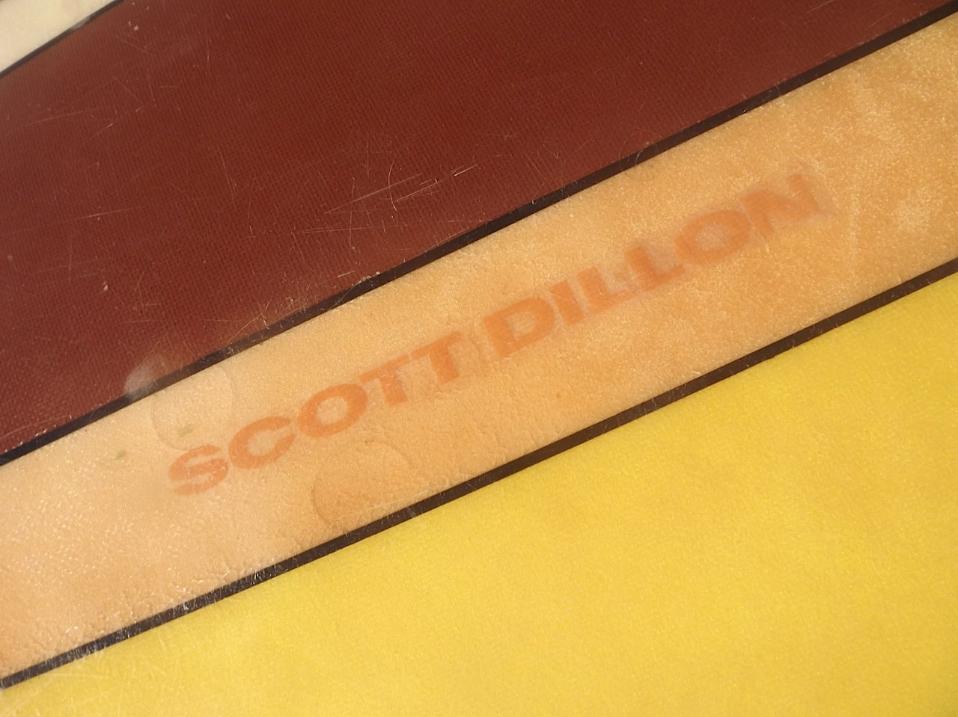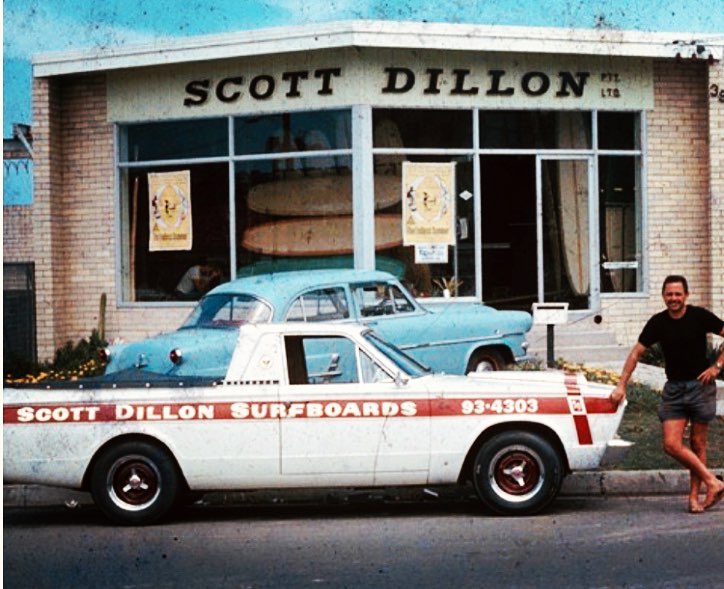Scott Brewster Dillon: He Did It His Way
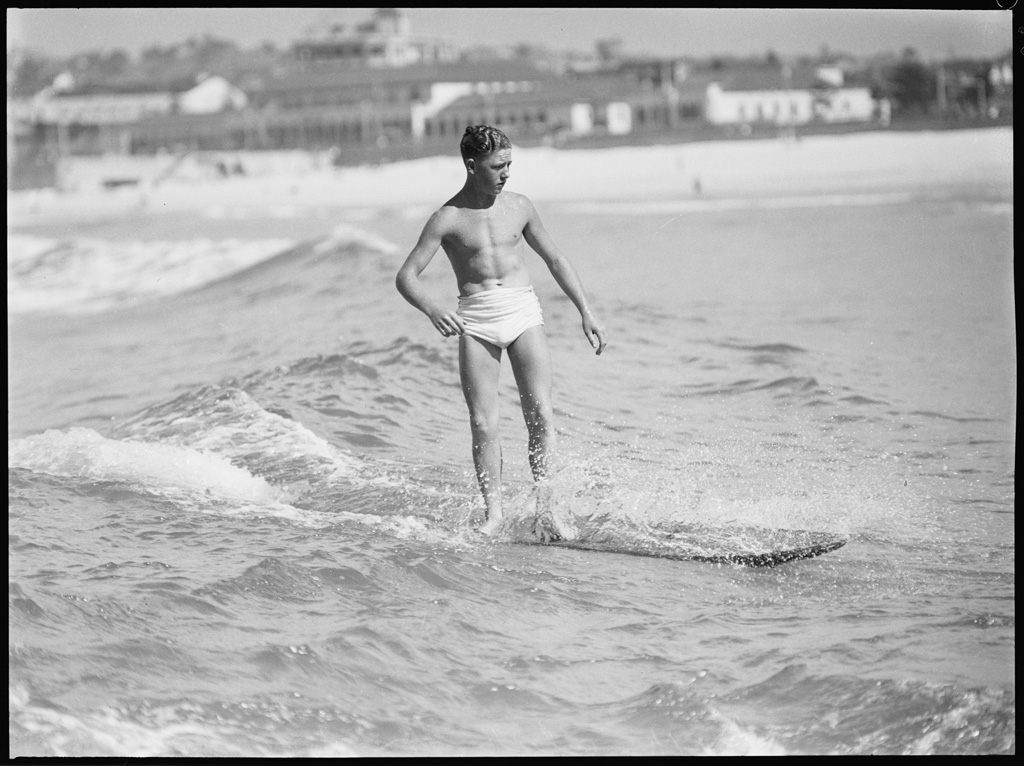
North Bondi Surfer - from album North Bondi Surf Club series, 20 October 1938 / photographed by Ivan Ives, Image No.: c20413_0024_c, courtesy Mitchell Library, State Library of New South Wales and Courtesy ACP Magazines Ltd.
Born the eldest child of Tasmanian born Joseph Henry Dillon and Helen Frances (nee Brewster) 'Scotty' grew up under the tutelage of one of the early 'Botany Harriers' in his father, while his mother, a gifted pianist and strong swimmer, was a daughter of George Frederick Brewster, one of the early 1898 swimmers and secretary of the Sandy Bay Swimming Club, Tasmania's oldest swimming club. Mr. Brewster was also involved in the committees of the Royal Hobart Regatta for decades and was the secretary of the Tasmanian Boxing Amateurs for many years. Mr. Brewster also served as a JP in the era when these were alike magistrates and sat in courts judging matters.
Joseph and Helen (called 'Lena') both lived in Napoleon street, Battery Point, which overlooks Sandy Bay, as youngsters.
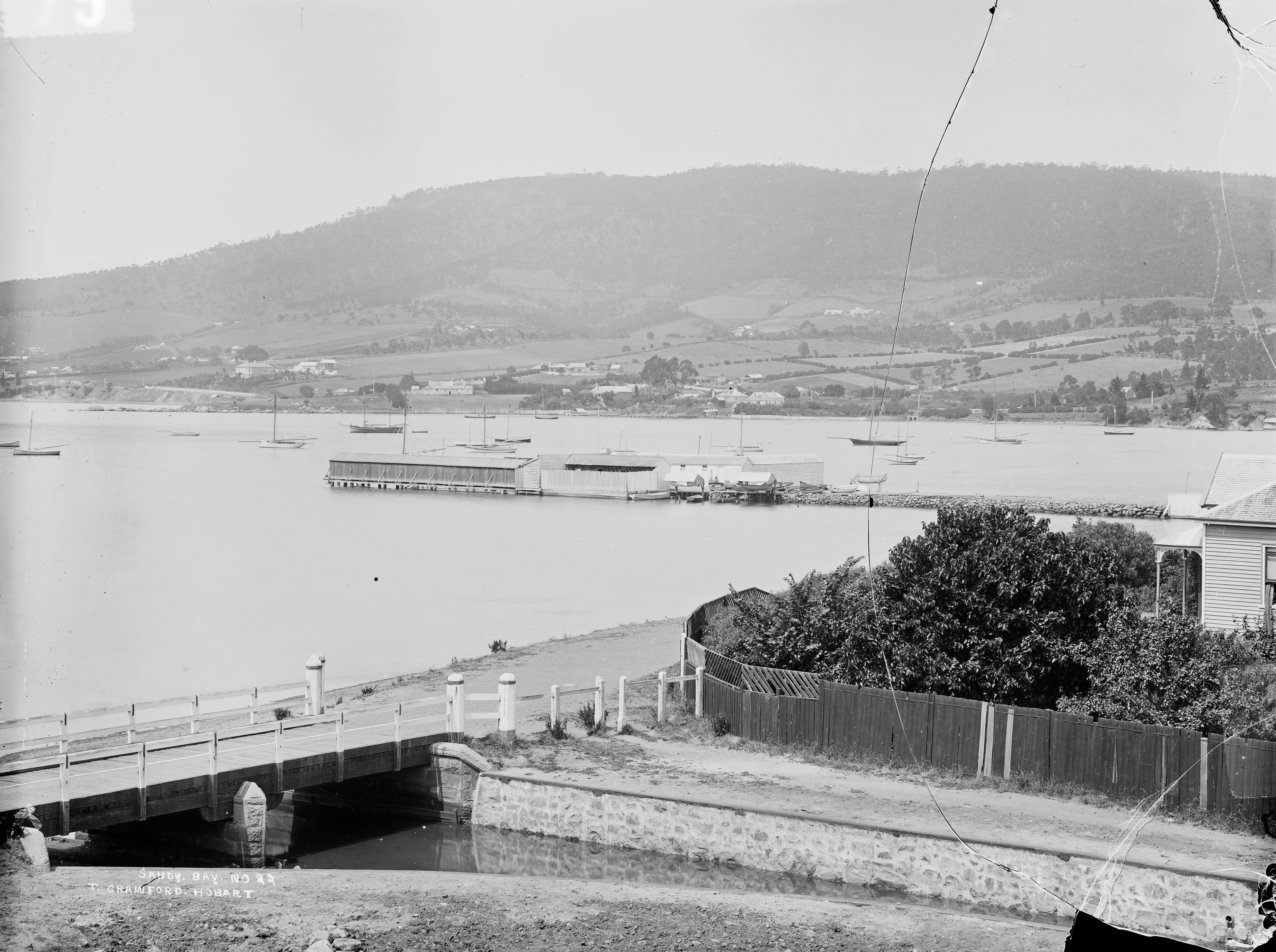
Sandy Bay Swimming Baths, January 1900 - photo courtesy Tasmanian State Library and Archives
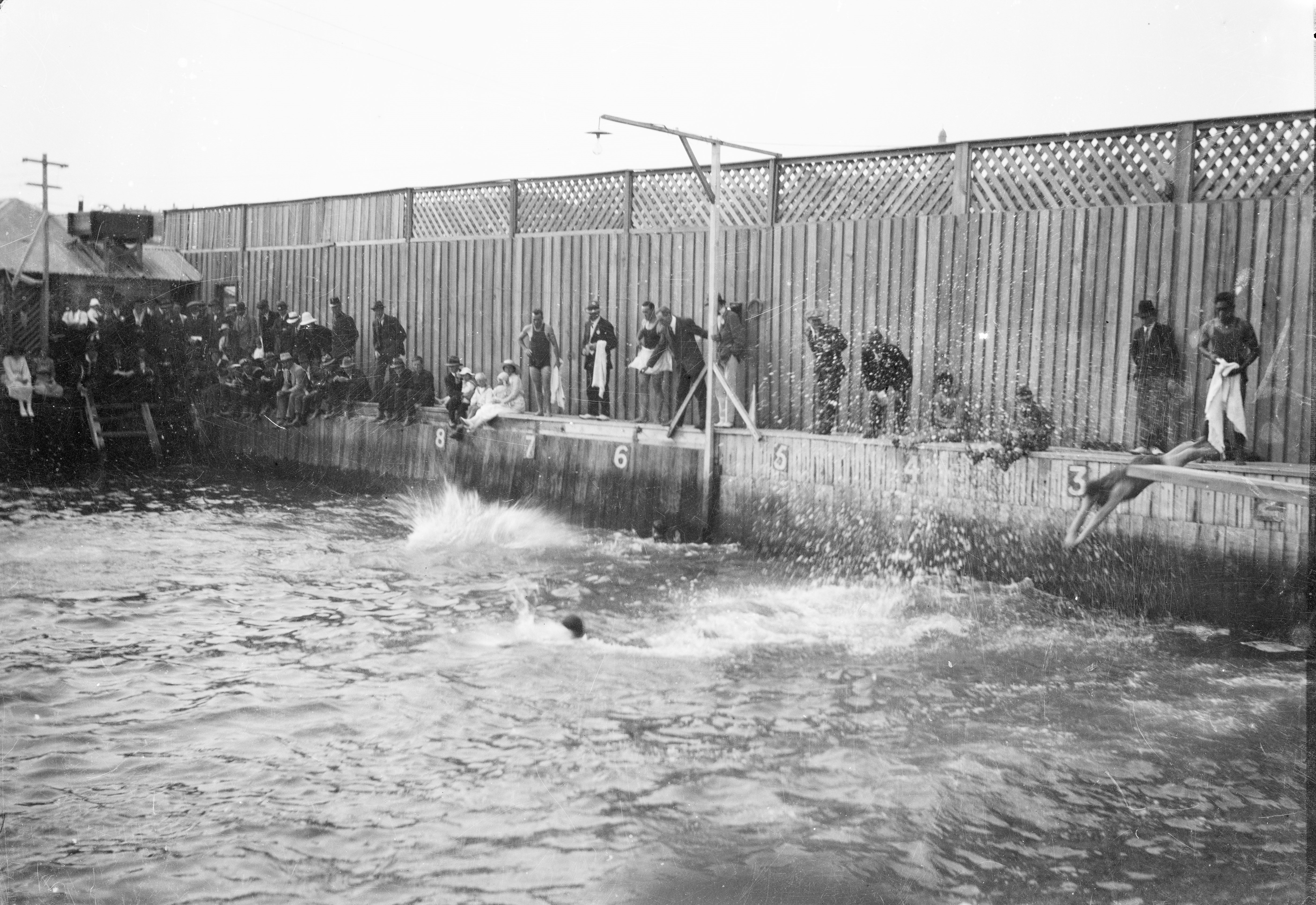
Sandy Bay Baths in 1920 - photo courtesy Tasmanian State Library and Archives - look who is at far right of this photo
Joseph Henry, called 'Harry' in numerous articles about his cross-country prowess, was born in 1901 to Joseph Charles Dillon, clerk to the Solicitor-General (and eldest son of Thomas and Alice Dillon), and Emma Elizabeth (nee Carruthers) a girl from Sydney. His grandfather, Thomas, served in Hobart Council for years and wasa bit of a larrikin, although well loved for his freindly demeanour towards many.
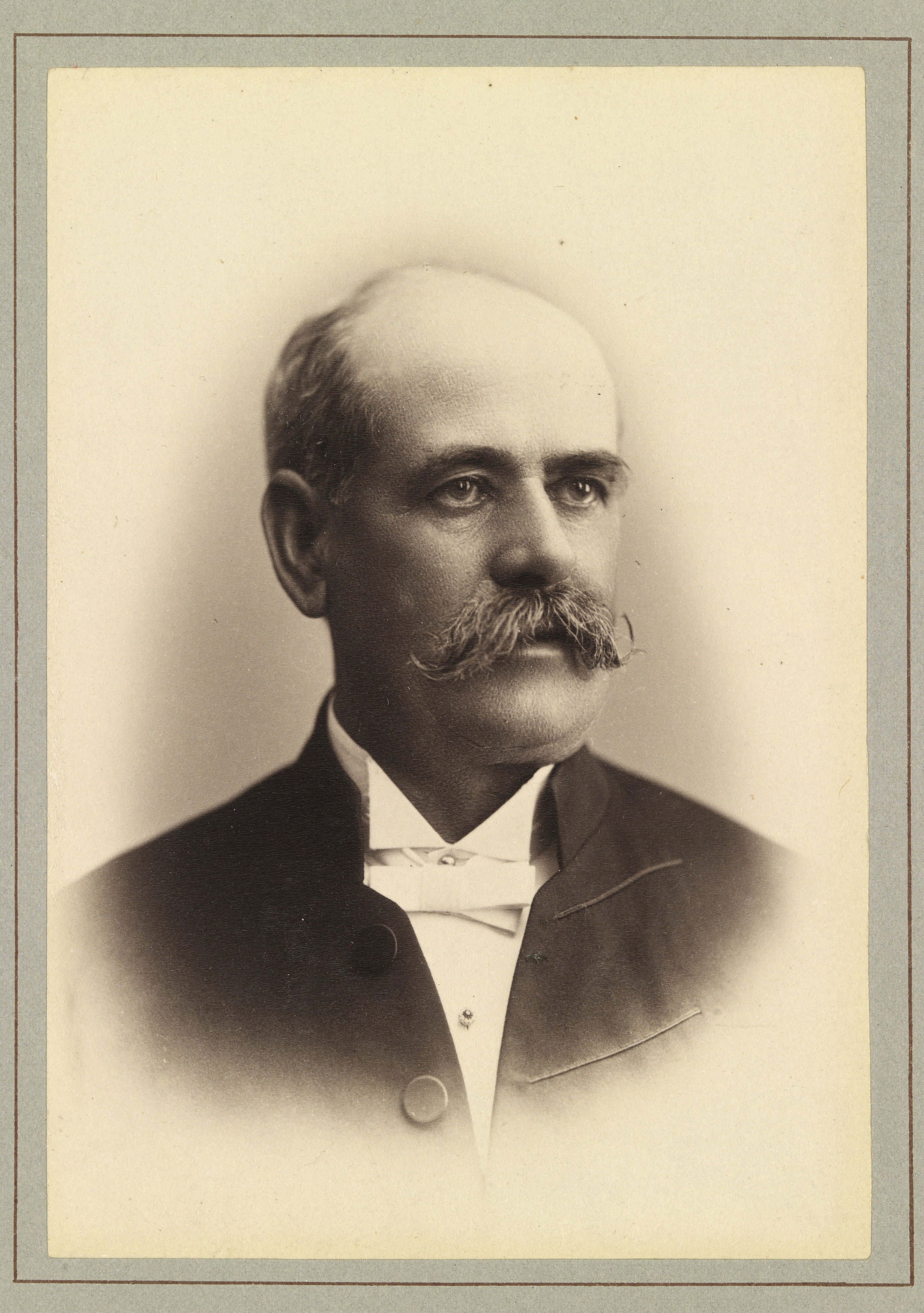
Thomas Dillon, died 1908 aged 61 - photo by J. W. Beattie, courtesy Tasmanian State Library and Archives
When Joseph's father died suddenly on the 2nd day of January 1915 his mother brought him and his siblings to Sydney to live.
Trips home by Harry, and even a rowing bout of 1924 as part of Sandy Bay's 'winning eight', were a prelude to the marriage in December 1924 of J.H. Dillon and H.F. Brewster. His brother Edgar, and sister Victoria also both married in 1924 - only their weddings were in Sydney. The couple returned to Sydney, where Joseph worked as an Accountant, he continued running as part of the Botany Harriers(from at least 1918), switching to become part of East Sydney Amateur Athletic Club at Rose Bay, where he subsequently took on roles as secretary and trainer - and included his son Scott in this when he was older.
Joseph H. Dillon is one of those champions of yesteryear that has slipped from the Australian annals, but where Scotty Dillon came from on both his father's and mother's side, and what he grew up amongst, shaped his whole life - from the year before this legend of Australian surfing was born:
ATHLETICS.
HIS AMBITION Dillon Shines At Rose Bay
HARRY DILLON, the ex-Botany harrier, is keen upon a journey to Adelaide next August as a New South Wales representative in the 10,000 metres cross-country championship of Australia and New Zealand. Judging by his display yesterday, he will have his ambition fulfilled.
Competing in the 41 miles road race staged by the East Sydney Amateur Athletic Club at Rose Bay, he completed the journey from actual scratch in 25 minutes 30 seconds, an average of 6 minutes 33 seconds per mile. This Itself Is fast travelling, but there is more merit than meets the eye, as his run was alone. Usually Milton Cameron shares the mark of honor, but yesterday was an absentee owing to a heavy cold. Stan McAlister ran well to secure second place, while limit-marker Frank Ward, the ex-South Sydney. He surprised the handicapper by gaining third position. Ward, although only fifteen, Is an object lesson to those many years his senior by his enthusiasm, determination, and good sportsmanship. ATHLETICS. (1927, May 15). Truth (Sydney, NSW : 1894 - 1954), p. 5. Retrieved from http://nla.gov.au/nla.news-article168680658
Dillon Played a Part
Eastern Suburbs athletic secretary and State selector, J. H. Dillon, played an important part in New South Wales' team success, in the Australian cross country championship at Melbourne yesterday. To him goes the credit of bringing back from retirement, W. J. Hyland, the light blue captain, who filled a creditable sixth place, in the biennially contested event.
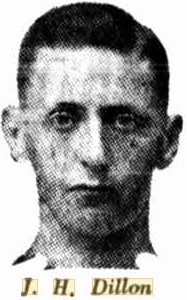
J. H. Dillon.
Dillon Played a Part (1933, August 6). The Sun (Sydney, NSW : 1910 - 1954), p. 20. Retrieved from http://nla.gov.au/nla.news-article231434208
The Dillons were living at Rose Bay when Scotty was born and still there when his sister Helen Marie was just a few years later:
DILLON.—June 9, to Mr. and Mrs. J. H. Dillon, Rose Bay.—a daughter (Helen). Family Notices (1931, June 10). The Sydney Morning Herald (NSW : 1842 - 1954), p. 10. Retrieved from http://nla.gov.au/nla.news-article16784499
A second daughter, Josephine Ann, was born in 1935.
J. H. Dillon, whom his mother had moved back to Sydney later in 1917, served in WWII in 5th Brigade the Reg. Reserves:
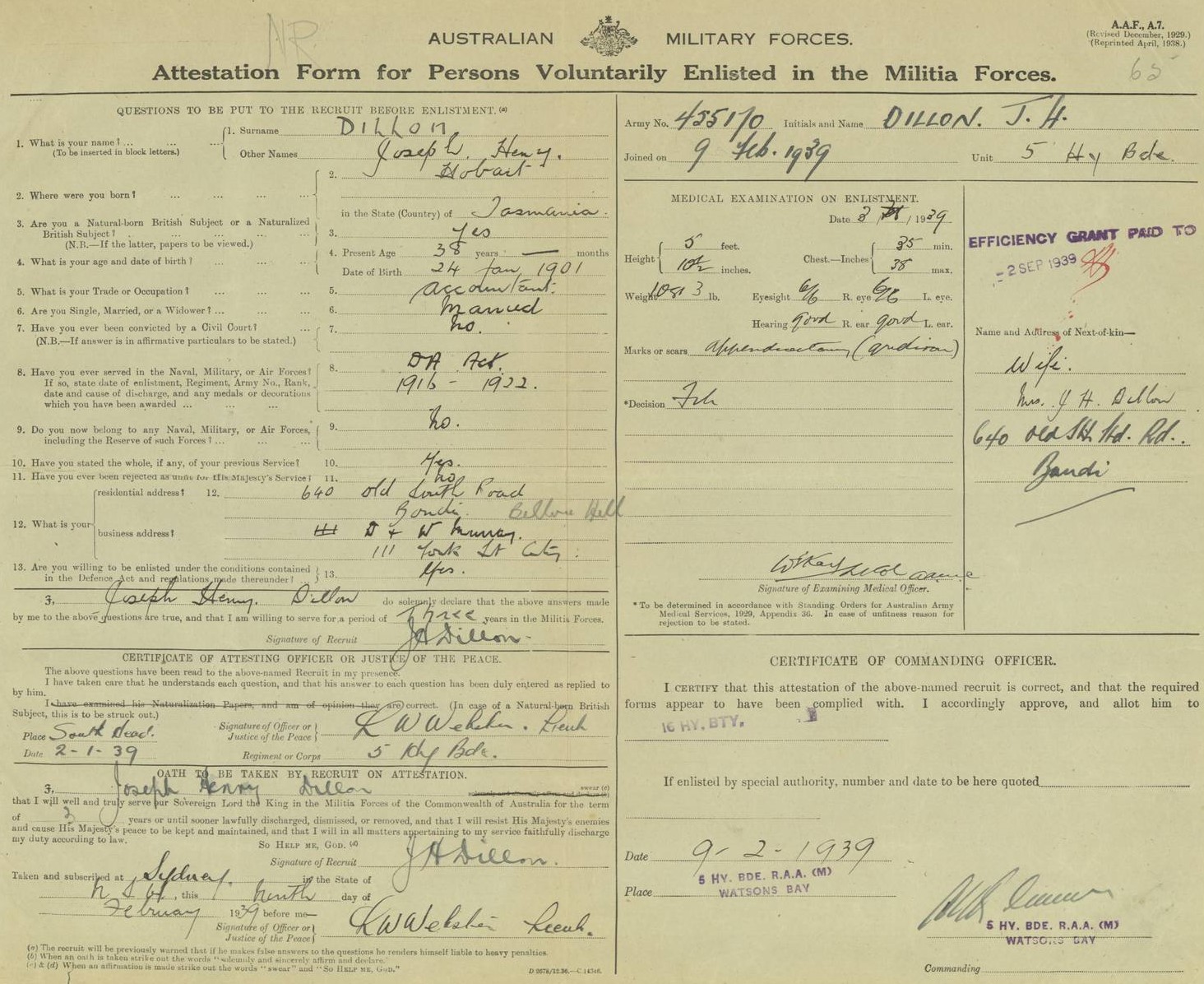
A few of the years on:
Husband, Wife Run For Fun
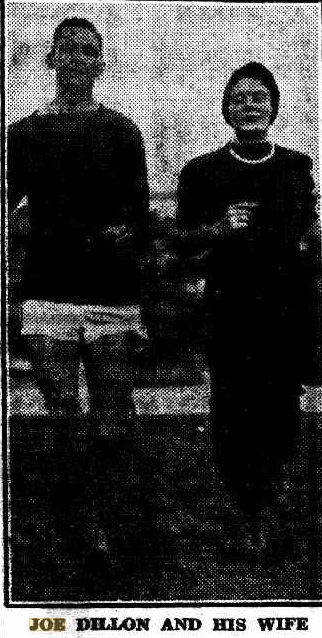
JOE DILLON AND HIS WIFE
SYDNEY - Mrs. J. H. Dillon helps her husband, Joe, one of the State's leading distance runners, in his training. She ran, trotted, jogged, and exercised like a veteran with him for nearly an hour at Rushcutters Bay Oval.
"Running is second nature to me," said Mrs. Dillon. "Every morning my programme is a mile run to the beach, a two-mile work-out on the sand, then a surf."
"And then a taxi or ambulance home ?" it was suggested.
"Not on your life. The mile run home is just what puts an edge on my appetite," retorted Mrs. Dillon.
REAL LIFE-SAVER
A few minutes later she was hurrying home to Bondi to prepare a meal for Joe and their three children, Scott (14). Helen (11), and Joyce (7).
Joe and his wife are also keen swimmers, surfer's, hikers and cyclists.
They are only sidelines in Joe's sporting activities. He has been competing in athletics since he was 17. That was 25 years ago.
Last week he was presented with the Royal Humane Society's bronze medallion for rescuing a man in a rough sea at Bondi last December. Husband, Wife Run For Fun (1942, October 7). Barrier Miner (Broken Hill, NSW : 1888 - 1954), p. 1. Retrieved from http://nla.gov.au/nla.news-article48407209
A few more track Scott Dillon's other developments in other sports - this is father and son, despite the wrong name for Scotty:
Fathers, Sons In Sport: Two Agree ; Two Rivals
Quaint angles on fathers and sons in sport: —
Veteran Sydney athlete Harry Dillon is working on a five-year plan to have his son, Alan, 16, win the NSW six-miles title in 1950. Dillon, sen., 45, Is one of the wonders of Sydney athletics. He competes with Eastern Suburbs, and is rarely beaten by his younger rivals. Every day at 6 am, winter and summer, father and son run two miles around the Bondi district. This Is followed by a surf or swim in the baths.
"Alan has won several short events, but I am concentrating on making him a distance runner," said the elder Dillon, today. "He is not yet developed enough to win distance races. As he matures, the pressure will be put on him. In five years, he should be ready to win the six-miles title "I do not believe in rushing young athletes. Many good runners are 'burned out' long before they reach their prime. "Many people ask how I manage to win races at my age. The answer is: Plenty of fresh air and not competing unless thoroughly fit. Above all, I was given time to develop before I tackled the champions." Fathers, Sons In Sport: Two Agree; Two Rivals (1945, March 14). The Sun (Sydney, NSW : 1910 - 1954), p. 12 (LATE FINAL EXTRA). Retrieved from http://nla.gov.au/nla.news-article231713587
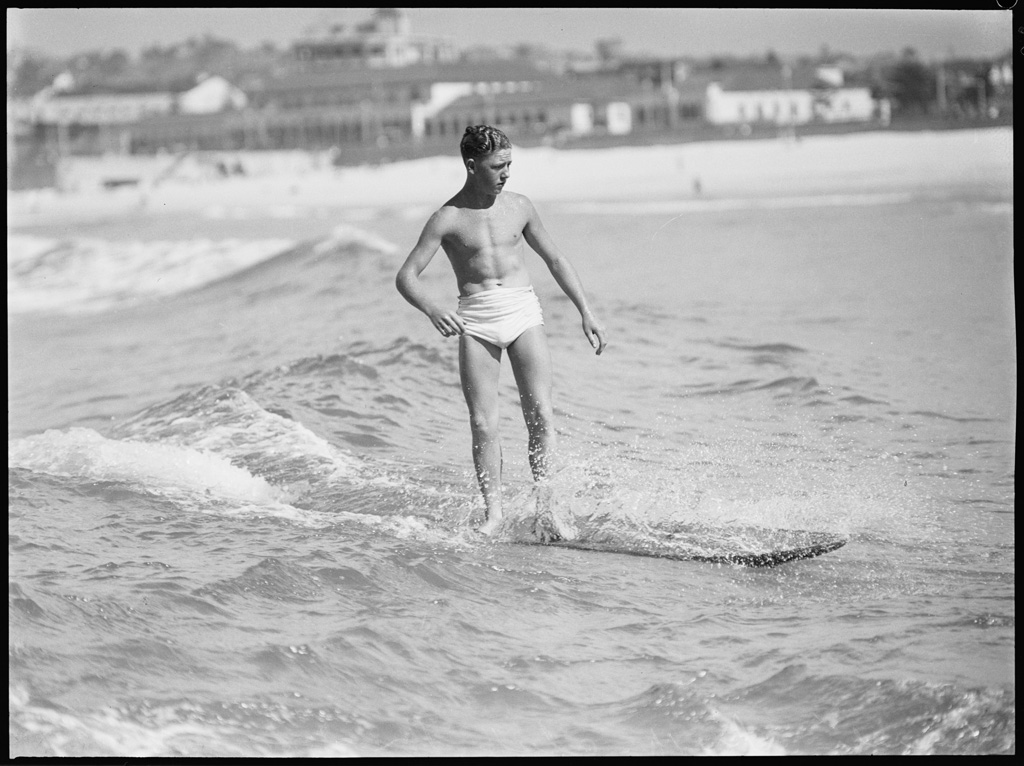
North Bondi Surfer - from album North Bondi Surf Club series, 20 October 1938 / photographed by Ivan Ives, Image No.: c20413_0024_c, courtesy Mitchell Library, State Library of New South Wales and Courtesy ACP Magazines Ltd. NB: These old Photographic Plates were printed in reverse.
Making a cake during and just after WWII, when rationing was still in place, was no easy feat and required a bit of planning:
On the cake were 400 candles
Mrs. Dillon, of Bondi, last week baked a special cake. It had to be large enough to hold 400 candles. Her husband is Harry Dillon, Eastern Suburbs veteran 45-year-old track star. His win in the interclub race at Erskineville Oval last Saturday was his 399th in 26 years of competitive running.
The cake will be cut the day he scores his 400th win.
Mrs. Dillon had originally planned the celebration for his 500th win. But Harry is getting on a little, and his wins fewer. Although Harry is confident he’ll run — and win — until he's 60, his wife is doubtful whether he will record many wins beyond the 400.
Harry has a son, Scott (17), and two daughters, Helen (14) and Josephine (10). Scott runs against his father in club races. Harry once had hopes of him reaching Olympic class. He trained him privately, developed his physique by cycling trips in the mountains and early morning summer and winter surfing. But Scott hasn't won a race in two years, is still many yards slower than his father.
He wanted to train Helen. He claims she is the best woman miler in Australia. But Mrs. Dillon believes a woman's place is in the home, won't let her take up athletics.
Harry has run two smart trials in the last few days. He is confident he’ll be eating cake within a fortnight. TODAY: Hugh Dash's Backstage Of Sport (1946, January 13). The Daily Telegraph (Sydney, NSW : 1931 - 1954), p. 30. Retrieved from http://nla.gov.au/nla.news-article248475671
ATHLETE'S 'COMEBACK'
Eastern Suburbs athlete Fred Packwood staged a great comeback when he won his club's 3-mile cross-country scratch race at Centennial Park yesterday in 15min. 6sec. Packwood who has been in the Royal Australian Navy for nine years, had his first run for six years, two weeks ago when he clocked 10 min. 4sec. over the Centennial Park course. Clubmates did not believe the time was right, but yesterday's win proved it no fluke. Veteran Harry Dillon was second in 15min. 13sec, with Ivan Rixon third in 15.41. Scotty Dillon. 16-years-old son of Harry, was inches behind Rixon in fourth place. Former novice cross - country champion Geoff Bowden made a reappearance after five years in the A.I.F., but was very much overweight and could only clock 16min. Present cross-country champiQn Don Campbell, competing in Randwick-Kensington's 3-mile handicap at Centennial Park, clocked 15min. llsec. George Frost, with a handicap of lmin. 20secs., won the race in 16 mins. 14secs. Clarrie Cumming was flat out to defeat junior Jack Clucas in South Sydney's four-mile road race at Tempe in 22.12. Clucas clocked 22.27. Bob Skinner ran -right through the field to win St. George's four-mile handicap in 21min. 54secs. at Ramsgate. With a handicap of 18mins., R Kelleher (St. George) won the invitation 18-mile handicap in 2 hours 4min. 39secs. at Botany. Silver Doyle, off scratch, recorded fastest time of 1.52.17. ATHLETE'S 'COMEBACK' (1946, May 19). Truth (Sydney, NSW : 1894 - 1954), p. 17. Retrieved from http://nla.gov.au/nla.news-article168769856
The trips 'home' don't report that his wife's father was very ill, he passed away in 1955. Helen's mother had died 20 years before, in 1935.
N.S.W. Athletes Here for State Titles
ELEVEN members, including manager Noel Harrod, of Eastern Suburbs Amateur Athletic Club, oldest club of its kind in N.S.W., reached Launceston late yesterday afternoon by boat train from Burnie.
THEY will compete in the Tasmanian amateur track and field games championships at York Park on Saturday. Forty-eight-year-old Hobart born, Harry Dillon, who will compete only in the three miles walk at Hobart on the second and concluding day (March 19), accompanied the party from Sydney, but joined the Hobart express at Western 'Junction. He will not be seen in Launceston. Members of the party are: Kevin Fetherston, middle-distance runner; Eric Young, pole vault; Bill Fowler, middle-distance and club champion over 400, 880, and one mile; Kevin Miller, hop, step and jump and broad jump; selected to represent N.S.W. in the 1948 Australian championships in Perth, but injured an ankle, and was unable to make the trip; Stan Allen, 220yds. and 440yds. hurdles, former N.S.W. junior champion hurdler; Bill Powell, hurdler, only junior in the party; Ivan Rixon, one and three miles, third in N.S.W. 10,000 metres championship in 1946; Ray Bull, sprinter, for whom a particularly bright future is predicted; Frank O'Rourke, two miles walk; and Jack Connelly, one and three miles; also specialises in 5 miles and marathon running. N.S.W. Athletes Here for State Titles (1949, March 9). Examiner (Launceston, Tas. : 1900 - 1954), p. 14. Retrieved from http://nla.gov.au/nla.news-article52668184
SILVER WEDDINGS
DILLON-BREWSTER.-December 10, 1924, at Hobart, Joseph to Lena. Present address: 212 Old South Head Road, Bondi. Family Notices (1949, December 10). The Sydney Morning Herald (NSW : 1842 - 1954), p. 38. Retrieved from http://nla.gov.au/nla.news-article18147667
Meanwhile, at Bondi:
100 Swim Close To Shark
STRONG WIND MUFFLES ALARM BELL
A shark cruised for 10 minutes within 50 yards of more than 100 surfers at North Bondi yesterday. A strong southerly wind prevented the swimmers from hearing the shark bell alarm.
While some surf club members blew whistles or shouted warnings, others swam to the surfers and ordered them to the beach. Beach Inspector Les Davidson swam 150 yards to warn some swimmers. The North Bondi Club's surf-boat crew chased the shark to sea. S. Dillon, a Bondi Club member, was beyond the breakers on a surfboard when he saw the shark swimming towards North Bondi. He returned to the beach and reported the shark to the Bondi Club beach patrol. The patrolman sent the alarm to North Bondi Club. Sharks also appeared at Maroubra and Bronte beaches. Surf-club crews drove the sharks away. Caught In Rip Several Manly and Narra-been surfers were in difficulties when they were caught in strong rips.. Manly lifesavers made 30 rescues. North Steyne beltmen Jack Sallick and Peter Geary each swam 75 yards to rescue a woman and a boy who had been swept out simultaneously. North Narrabeen lifesaver Harry Paul rescued a boy who was being swept towards rocks. Because of bad weather, only small crowds attended the beaches. Seaweed banked up to a depth of 3ft. in the bathing area at Cronulla. Earlier heavy seas washed seaweed on to most of the beach. Cronulla Surf Club vice-captain (W. Philpott) said that the weed would give off an offensive smell when it dried out. 100 Swim Close To Shark (1948, February 9). The Daily Telegraph (Sydney, NSW : 1931 - 1954), p. 5. Retrieved from http://nla.gov.au/nla.news-article248279140
Same place and almost the same time the next year:
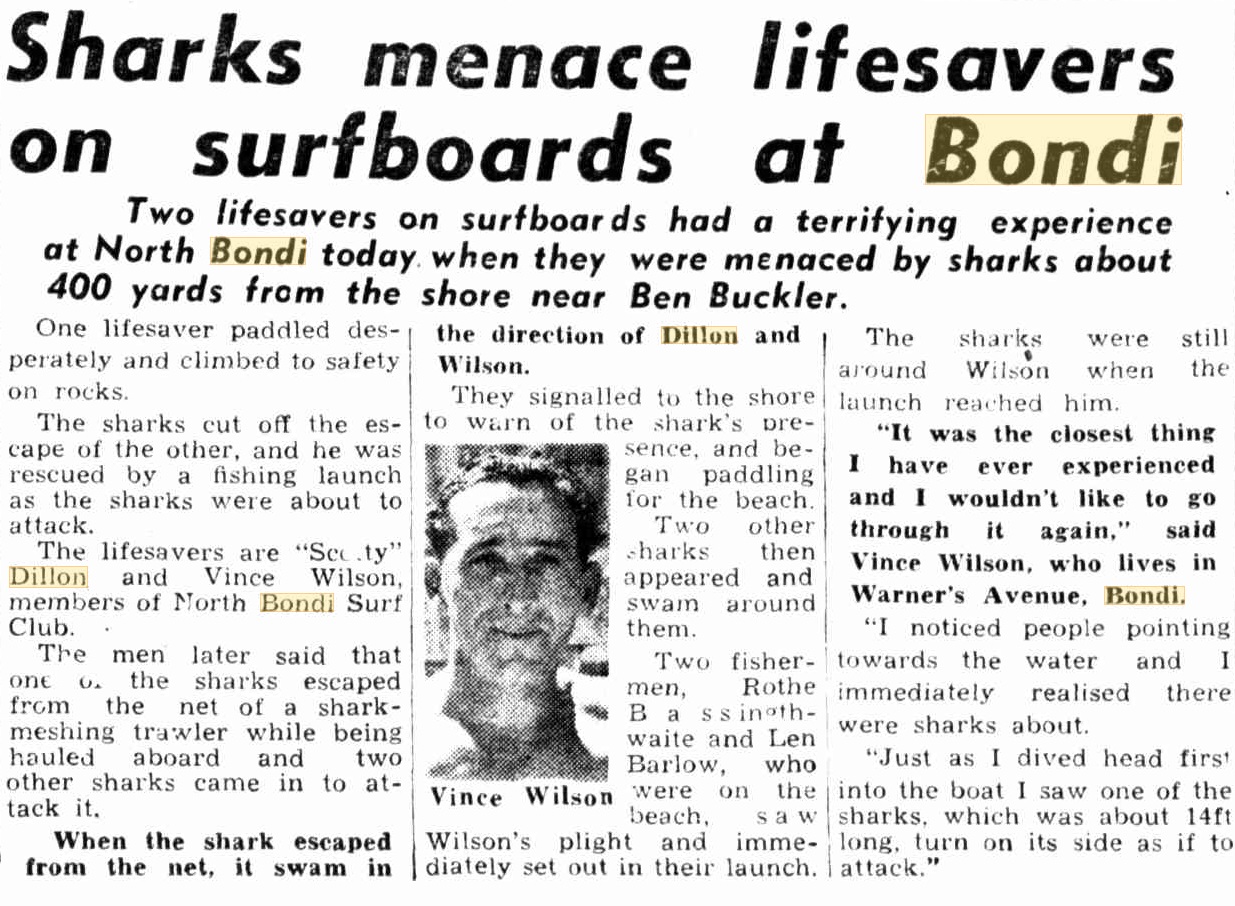
Sharks menace lifesavers on surfboards at Bondi (1949, January 14). The Sun (Sydney, NSW : 1910 - 1954), p. 1 (LATE FINAL EXTRA). Retrieved from http://nla.gov.au/nla.news-article230238556
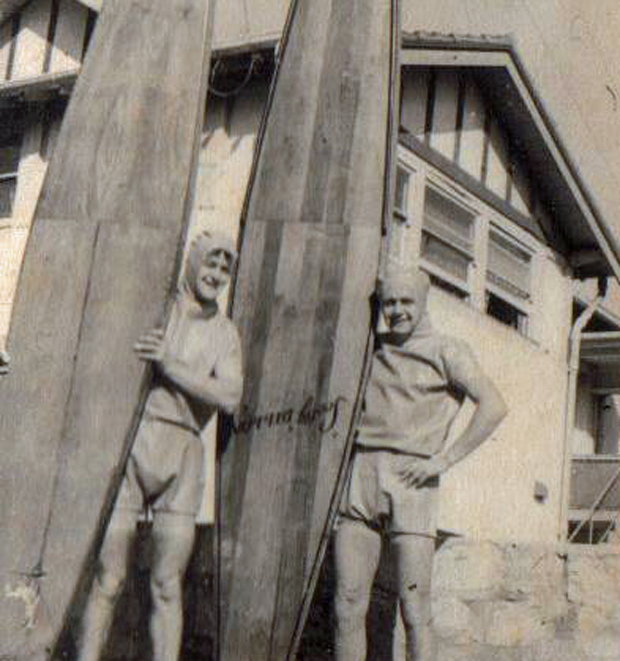
Barry “Magoo” McGuigan and Scotty with their homemade wetsuits, Bondi, late 1940s.
Joseph Dillon got his Bronze Medallion in 1932 and was Secretary-Treasurer of Bondi Surf Bathers' Life Saving Club. At age 15 Scotty became a lifesaver with the club. Both Bondi Surf Bathers and North Bondi were utilising surfboards as part of their equipment with some reports showing they had enough surfers to send out up to 50 to 'ward off sharks' during carnivals - possibly scrambling onto the closest rocks if they did happen along, as Scott did in the above incident - as you would!
His sisters would also join the other Dillon family members on the sand. Helen went on to become a famous swimmer and competed in many triathlons. Both girls married, at Bondi, Josephine in 1953 to Peter Anthony Murphy and Helen in 1954 to Owen Harold McCormick. Like their parents and their grandfather, the girls both had that spirit of being generous to others that marked Scotty's nature too:
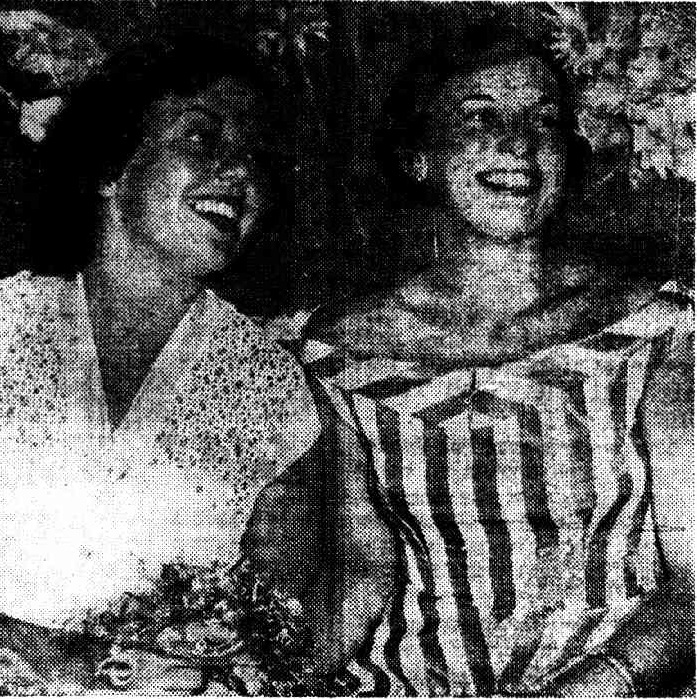
AT CHRISTMAS PARTY. Helen Dillon (left) and Maree McGrath, members of the Bellevue Hill younger set for the Spastic Centre, at the younger set's dance at Florida House last night. WOMEN'S NEWS (1950, December 21). The Daily Telegraph (Sydney, NSW : 1931 - 1954), p. 12. Retrieved from http://nla.gov.au/nla.news-article248409778
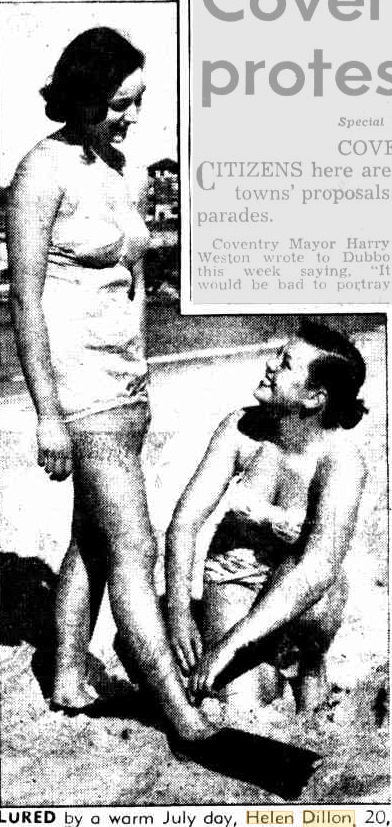
LURED by a warm July day, Helen Dillon, 20, of Bondi adjusts flippers for Berenice Harry, of Bellevue Hill. Both swam at Bondi. SURFING IN THE SUN (1951, July 29). The Sun (Sydney, NSW : 1910 - 1954), p. 44. Retrieved from http://nla.gov.au/nla.news-article230226456
Scotty kept following what would make his mum's father happy and had some great success. Some sources state he began boxing at Bondi Surf Bathers' Life Saving Club boxing events, others cite this as a sport he took part in as a student at Sydney Grammar School. North Bondi SLSC did have wrestling during the 1930's and 1940s,
Tasmanians Games Chance!
TASMANIAN bantamweight boxer Scott Dillon, who won the final of the bantam-weight division in Sydney last week, is regarded by amateur boxing officials in Sydney as a definite prospect for the next Olympic Games.
Dillon won the bantam title when he defeated E. Arnold by a knock-out in the first round. Dillon also is one of the leading surf board exponents of the Bondi Surf Club, and is a proficient skier.
He is a grandson of Mr. G. F. Brewster, of Hobart, and a great grandson of the late Mr. H. Dillon, well known in Tasmanian regatta circles about 1900. Tasmanian's Games Chance (1950, July 14). The Mercury (Hobart, Tas. : 1860 - 1954), p. 10. Retrieved from http://nla.gov.au/nla.news-article26715105
Olympic prospects in fight finals
Two Olympic Games prospects will contest finals of the State amateur intermediate boxing championships at Sydney Stadium on Wednesday night. They are middleweight Tony Madigan: and bantamweight Scott Dillon. Madigan will fight Arnold Hamilton, who impressed with a three-rounds knockout of C. Quinn last Wednesday night. He wore Quinn down with solid left hooks to the head. Madigan is unbeaten, and already has won a State intermediate title. Former Australian champion Hughie Dwyer trains Madigan. who is. expected to win.
Dillon, a son of former champion athlete Harry Dillon, will meet B. Gleeson. Dillon also is unbeaten, and has won most of his fights on knockouts. A 34-years-old wrestler, Terry Reilly, will meet George Maina in the final of the welterweight wrestling championship. Reilly took up wrestling two years ago because he was losing form as a distance swimmer. He took up wrestling to build up his strength. Olympic prospers in fight finals (1951, May 28). The Daily Telegraph (Sydney, NSW : 1931 - 1954), p. 19. Retrieved from http://nla.gov.au/nla.news-article248670629
...in the N.S.W. amateur boxing championship finals at Sydney Stadium last night.
Scott Dillon was aggressive in winning the bantamweight title. Although his defence was lacking he plunged long rights and lefts into Bill McCon nell's body and stopped him in the second session. Dillon needs to sharpen up his defence if he hopes to gain higher honours. VIC PATRICK At Amateur Finals Flyweight Is Best Prospect (1951, November 8). The Sydney Morning Herald (NSW : 1842 - 1954), p. 8. Retrieved from http://nla.gov.au/nla.news-article18238368
Scotty missed out on going to the 1952 Helsinki Olympics. Tasmanian Ron Gower was sent as the bantamweight contender - so his grandfather would have been happy either way - he been one of the judges of Gower's earlier fights during the 1930's in Hobart. Ron Gower had also been an Australian boxer at the 1948 London Olympics:
Something went wrong with the last Olympiad's fights and I hope it won't happen at Helsinki this time. Our immediate concern for Olympic boxing is how our boys will fare. Apart from Tasmanian-born Errol Flynn, now a film star and welter champ of the 1928 Amsterdam Olympics, no Australian has won an Olympic fight title.
... Gower then went to the 1948 Olympics in London and was unlucky to meet the eventual flyweight title winner in the Quarter final He was outpointed. Gower was over in Perth in 1949 for the Australian championships once again. Ron won the flyweight title again that year and he represented Tassie in the Aussie championship last year. By this time Ron was considered a "natural" for any championship selec-tion. He fought as a bantam and clearly won the title. Returning from Brisbane after being narrowly beaten in the featherweight class our State feather champ Geoff Charlton had great praise for Gower. "He was the only man there who was really good," Geoff told me. "He just couldn't be hit. I've never seen anyone so elusive. He ducked everything that was thrown at him and threw back punches that were quicker than your eye could catch." Once more Gower has been selected to represent us at the Games. I wonder if 5 State titles, 3 Aussie titles and 2 Olympic trips is a record for an amateur boxer in Australia? ... JOHN MURPHY REVIEWS OLYMPIC BOXING HOPES (1952, July 5). Mirror (Perth, WA : 1921 - 1956), p. 11. Retrieved from http://nla.gov.au/nla.news-article75779989
Mr. Gower was not victorious. Also: Errol Flynn did not compete in the 1928 Olympics - no Australian represented in boxing. New Zealand did and their sole gold medal at that Olympics was from their boxer Ted Morgan in the welterweight division - so close, but not really, and definitely no cigar there.
Scotty began free diving and spear fishing at Bondi in 1946 during the very early era of the sport, with Don Linklater, Andy Armstrong, Spud Murphy, Jack Murray and Vic Ley Sr before the foundation of the Underwater Spear Fisherman's Association (in 1952). He later went professional spearfishing in Ceylon where one of his fellow Bondi lifesavers preceded him:
COLOMBO'S exclusive Otter Club will affiliate shortly with the Surf Life Saving Association of Australia. Former Bondi Surf Club coach, Harry ("Salty") Nightingale, is pioneering the surf movement at Colombo, where he is teaching swimming. Nightingale recently gave an exhibition belt swim, R & R and a surfboard display in rough surf. It's rough because of the monsoons, but "child's play" compared with Australian surf, he says, in a letter to Geoff Allen. Nightingale is already training three squads for surf lifesaving medallions and has supervised the manufacture of three reels, five surfboards and three surf skis. Squads are being formed by colleges, and the police.
Nightingale says he visited the palace of the last of the Singalese princes to teach him to swim. Close to the shore of a large lake, Nightingale demonstrated arm and leg actions in the water and after an hour looked up and saw natives on either bank with .303 rifles pointed at the water. "What is ail the artillery for?" asked Nightingale. "Oh, that," replied the prince. "Sometimes a crocodile visits us and I would not like to see you taken before you teach me to swim." Nightingale is coaching 15 selected Ceylon swimmers for the 1948 London Olympic Games. He gives them a strenuous preparation modelled on Japanese methods. Although times are comparatively slow, all the trainees are making good progress. The Surf Lifesaving Association of Australia may send a team to Ceylon this summer, says Association publicity officer Jack Dillon. Reel alarm among the crocs (1947, September 7). The Sun (Sydney, NSW : 1910 - 1954), p. 27. Retrieved from http://nla.gov.au/nla.news-article228974737
Men Reach Ceylon On Novel Tour
COLOMBO, Friday.-Three young Australians, who are spearfishing their way around the world, have arrived in Ceylon, where they plan to spend a month. They are Messrs. Bruce Laird (28), a stevedore, and the New South Wales heavyweight boxing champion, Scott Dillon (24), travelling salesman and the amateur bantamweight boxing champion, and Barry McGuigan (28), a butcher, who is an expert surfboard rider. The trio expect to take four years over their trip, which will include England and Canada. -Reuters. Men Reach Ceylon On Novel Tour (1953, April 25). The West Australian (Perth, WA : 1879 - 1954), p. 20. Retrieved from http://nla.gov.au/nla.news-article55799302
The boys kept going - their ages jumping up and down, their companions growing:
SIX TRAVEL EUROPE IN AN OLD TAXI
DUSSELDORF, Tues.-Six young Australians who arrived in Dusseldorf in a 20-year-old London taxi caused a traffic jam when hundreds crowded round their vehicle. The taxi, bought for £68/5/, had a chimney pot tied to the spare tyre and a large brush to the front hood. A white dotted line was painted down one of the cab doors. The door bore in large white letters the inscription: "To open tear along the dotted line."
The Taxi's six owners, who left Sydney on April 1, are Scott Dillon (25), salesman; Bruce Laird (29), stevedore and former heavyweight wrestler; Barry MacGuigan (24), butcher and surfboard rider, all of Sydney, and three 22-year-old Melbourne men-Adrian Gallienne, accountant, J. Beard, engineer and swimming champion, and Jim Goodwin, tailor. The Australians' baggage is filled with beer mats, hotel labels, coins and souvenirs they have already collected in Ceylon, India. Egypt, Britain, France, Belgium, Denmark, Sweden and Norway. SIX TRAVEL EUROPE IN AN OLDTAXI (1953, July 29). The West Australian (Perth, WA : 1879 - 1954), p. 9. Retrieved from http://nla.gov.au/nla.news-article49223241
Because you can never have enough beer mats! And of course Barry Magoo McGuigan is the gentleman responsible for the Magoo Classic and still held each year by the Central Coast Malibu Boardriders.
Lumber-jacking in Canada and Alaska and professional boxing televised in Canada and the northern US occupied some time. During that sojourn Scotty apparently surfed the biggest waves he could find in Mexico, Hawaii and California.
He was home by mid 1956 and married Mitzi, they had six children. He began making surfboards with Noel Ward in a shed in Wellington Lane Bondi. The year 1956 was also when the Americans, here to be part of the surf life saving display in Victoria adjacent to the Olympic Games, brought their balsa wood surfboards with them and put on displays at Cronulla and Avalon Beach in November. These guys were riding across the waves instead of just in on a straight line, they could turn!
.jpg?timestamp=1544927972813)
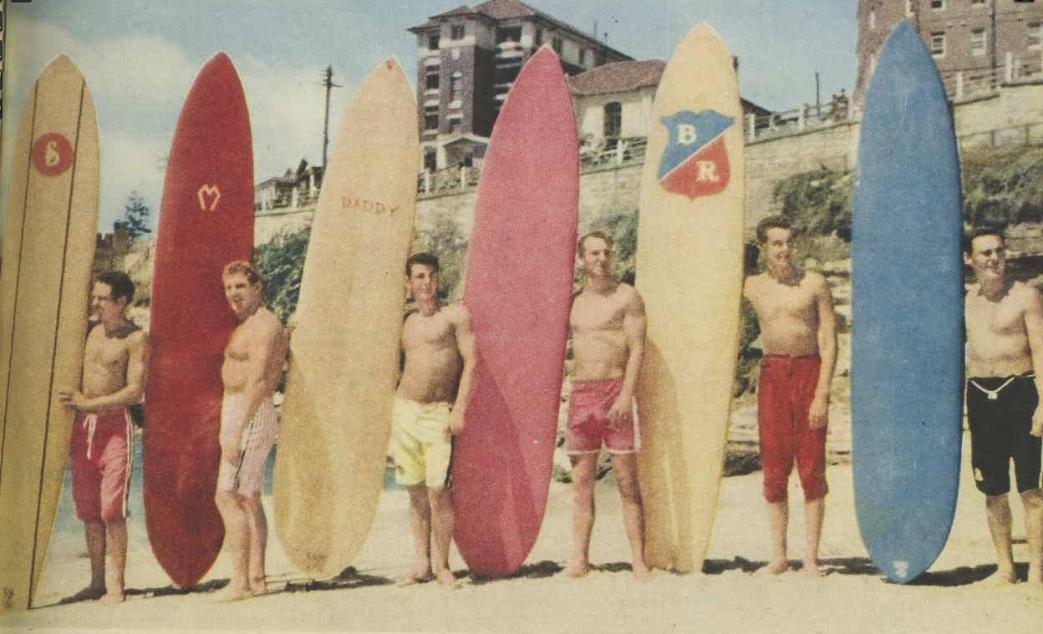
IN LINE on South Bondi Beach are members of the South Bondi Board Club. From left are Scott Dillon, "Bluey" Mayes, Andy Cochran, Rod Cartlidge, Barry Ross, and Des Price. Some wear long pants, and have foam rubber built into the knees, to protect their legs, especially when paddling their surfboards out to catch a wave. From Hot doggers' of the surf (1958, December 3). The Australian Women's Weekly (1933 - 1982), p. 3. Retrieved from http://nla.gov.au/nla.news-article48077087
In 1959 he went alone and Dillon Surfboards moved to the northern beaches of Sydney where a new factory and showroom was set up in another shed at the corner of Pittwater Road and Winbourne Road Brookvale. More room at 41 and then later, 39 Winbourne road then followed. He was sharing his knowledge and in between getting more endorphins surging through his system by catching waves - endorphins is what he'd been having regularly ever since he could run with his dad at 6a.m., for an hour prior to that early surf.
He was surfing at Narrabeen anytime there was a swell - would shut up the shop at Brookvale and off they'd all go. Narrabeen wasn't the only wave they rode. In an interview that formed part of the 2008 ABC two-part series “Bombora” Scotty said
'...we’d hear that Narrabeen was on. We had that many signs made – ‘Gone surfing’, ‘back later’, ‘away for an hour’, ‘we’re not here’, ‘could be here later’ — we had all these little signs. ‘Which one should we put up today?’ We’d put up a sign and go to Narrabeen. We’d all be in my ute with all the boards sticking out the back and Lynne’d be sitting at the window and as we’d go past Woodsy’s, we’d slow up and Lynne’d yell ‘Darryl, we’re going surfing!’ It was so cruel but they were fabulous days. it wasn’t run like a business, it was run like…I dunno what it was run like. It was run like nothing on bloody Earth. Just weird but it was good fun. It was good fun, you know. '
Bomboras were the things we used to go looking for. Like Queenscliff bommy. We heard this day the surf was really big, so we went down there, Bobby Pike, Dave Jackman and myself, we set up on the point there, we all had our gun boards with us and we looked out and it looked beautiful you know, and ‘Bloody hell, how are we gonna get out there?’ And Dave said ‘Oh I’ll try and get out through Harbord.’ I said ‘Right, sure you’re gonna get out through Harbord.’
Bob and I were sitting there watching to see how he was gonna go. We never thought for a minute he’d get out. So out he goes and sits way out on the left hand side, got knocked back, knocked back, knocked back and kept battling away there and finally he got out and he caught the first wave, as you well know, ever to be ridden at Queensie Bommy. He still owns that distinction of riding it for the first time. The next day, however, it was bigger and it was cleaner and Bob said ‘Now we’ve gotta go out there. I’m not gonna go out where Dave went, how about we paddle out the Bower and we’ll paddle down.’ It was that big, there was that retaining wall in the bay (at Shelley Beach) with a little gap in it, and the waves were breaking and going right up, through the gap and part way up the hill. We had to stand there trying to pick the right time to go and run and dive through the gap and paddle like mad.
We got out the Bower which was a battle to start with, turn left and paddle all the way down to Queenscliff, which is a bloody long way, but we were on eleven foot balsa guns so it wasn’t too bad.”
Southside journalist Kerry Yates was all over it:
DOWN THE MINE" ON SURFBOARDS
By KERRY YATES
"Who are these handsome surfboard champions? Where are these beaches?
Can I REALLY learn to ride a board from the instructions in the book?"
THESE were just a few of the questions I fired at 19-year-old Sydney boy Lee Cross.
Lee, a suntanned blond from Bronte Beach, had just shown me a copy of the ''Australian Surfer," a book which he had written and published himself.
.jpg?timestamp=1544923809349)
PETER THOMAS, of Manly (left), wearing zip-tweeds, "goes down the mine" at Fairy Bower. Below, three of Sydney's outstanding riders show what they can do on a surfboard - (from left), Johnny Payne, of Newport, rides toes-on-the-nose. Bob Evans, of Queenscliff, ready for a "head dip" (diving off), and Bernard "The Midget" Farrelly doing a perfect "quasimoto." Ron Perrott, of Harbord, took the pictures on this page and the one at the foot of the opposite page.
'"Grab your swimsuit next Sunday morning," he offered. ' "and we'll Ix- oH with my surf board to lind out."
So at 8 o'clock that Sunday morning Lee and some of his surfing mates called in a car with surfboards tied on the roof to take me along on their usual weekend wave hunt. The forecast was that the best surf would be rolling on Sydney's northern beaches, decided to start at Fairy Bower, near Manly. Travelling north to Palm Beach, we would have 16 surf beaches to choose from
The boys said they would looking for "hot-dogging'' wave (long, tapering swells; on uni. they could "go down the mini (ride their boards, sometimes hundreds of yards .
We beeped our car horn to a passing truck with surfboard piled on top. I buttoned a heavy coat over a chunky sweater and began to feel excited about surfing on a sunny winter's day.
As we crossed Sydney Harbor Bridge to the north side ( I was strictly a south-sider, coming from Bondi!), Lee Cross told me a little about himself and why he wrote his book on surfing.
Lee has been a keen surf-board rider for four years and spends most of his weekends and holidays riding the waves. Since he left high school two years ago he has worked with a North Sydney advertising company.
He believes that surfing should be given more encouragement as a world-wide sport.

DAVID JACKMAN, of Harbord, on one of the mighty waves surging over the Queenscliff bombora last June.
So Lee set out to produce a book about the Australian surfer, the best surfing spots, how to ride a surfboard, about the new South Pacific Surf Riders' Club (the first successful attempt to form a club to cater for the needs of the surfboard rider), with pictures and news about the local champions.
And he did just that, with the help of some of his teenage surfing mates.
The dramatic cover shot of a surfboard rider was taken by 17-year-old Terry Flemming, of Bronte, a trainee photographer with the Sydney Water Board.
Illustrations and jokes were drawn by an 18-year-old East Sydney Tech, art student, David Letts, of Newport.
Lee was telling me of his plans to bring out a second edition of the book before the end of the year when we arrived at Fairy Bower.
One of the "Bower Boys" yelled that the "waves were on" and the surf was "too much" (his term for fabulous).
We raced to the top of a cliff overlooking the spot where the boards were starting their journey "down the mine," about one mile off Manly Beach.
The surf looked wild and rough, but the boys had it mastered, and the champs of this area, like "Nipper" Williams, Hob Pike, and Glen Richie fall pictured in the book), dared to ride with no fear of hitting the craggy stone bottom.
.jpg?timestamp=1544923880449)
BOB PIKE, a renowned "Bower Boy" is hit by a backwash from the beach while cutting across a ware.
We were off again, giving Manly a miss, and were heading for a closer view of the Queenscliff bombora.
The great bombora, where the sea surges over seven layers of rock, nearly two miles out from North Steyne Beach, thunders in a big sea.
It has been conquered by only a handful of boys, including 21-year-old Dave Jackman, of Freshwater.
Three months ago "Jacko" successfully cracked four of the mighty bombora waves. (See picture above.)
Northwards again, we passed Freshwater, Curl Curl, Dee-why, and Long Reef without stopping. The surf was too big and there was danger of losing surfboards, which would go crashing against the rocks and so "ding" (a bang which splits the fibreglass on a surfboard) badly.
The boys told me that Long Reef usually supplies the works-everything from 3ft. to 30ft. waves. The top man among some mighty locals of this area is Peter Clare, the senior surf-board champion for 1961.
The Collaroy boys were really "hot-dogging" on "Pitt Street" shoots (waves with five or six riders catching them), but we were off to find where the surfboard riders from the south side had "camped" for the day.
We didn't have to go far. As we reached the sands of North Narrabeen we could see cars, surfboards, and riders, and we knew that this was THE beach for the best surf.
Shark scare
North Narrabeen is best known as the "home-water" for Bernard ("The Midget") Farrelly. At 16 "The Midget," a surfboard-maker by trade, is the junior champion of the Sydney surf-riders, and in November he is going to Hawaii to compete in the International Surfing Championships.
Lee Cross and his friends untied their surfboards from the top of the car, changed into their "zip-tweeds," and were off into the surf.
I was at the edge of the water, reach to take my first plunge of the season, when there was a yell and everyone headed for shore. I looked out to sea about 150 yards and saw three shark fins circling the area.
Everyone was quick to agree to head further north in search of another beach.
But we were out of luck. At every beach the waves were too big for me, so we headed back to Collaroy, where we watched the experts do their surfing tricks.
Some were riding "toes on the nose" (standing with feet on the front of the board), some were going for a "wipe out" instead of cutting off a wave when it begins to dump, they keep on riding it till they are thrown off the board), and others were crouching in "quasi-moto" style (body bent nearly in two with one hand stretched out in front and one behind).
We knew that the surf back home at Bondi was flat, so the boys finally took me there to learn to ride a surfboard from the instructions in the "Australian Surfer."
I put a jumper over my swim-suit. The sun had gone and a wind was blowing, but I wanted to have just one go at trying to ride.
I found it easy to kneel on the board as long as I kept my hands paddling. I tried and tried to stand up in one action, as the book said I should, but I can't even do that on land!
.jpg?timestamp=1544923603759)
LEE CROSS, 19, author and publisher of the "Australian Surfer," is an expert on the surfboard, too.
After about 30 minutes I learnt to stand in a strictly nonfeminine fashion (one leg struggling up after the other).
In spite of the comments from Lee and his mates that the fin must have been stuck in the sand" just because I could stand up, I was sure that I'd be a surf-board rider one day. "DOWN THE MINE" ON SURFBOARDS (1961, September 20). The Australian Women's Weekly (1933 - 1982), p. 4 (Teenagers' Weekly). Retrieved from http://nla.gov.au/nla.news-article47249167
On November 20th, 1961 Big Wednesday premiered at Anzac House in Sydney. In 1961 a group of local surfers went to Hawaii as members of the then newly formed Narrabeen based South Pacific Surf Riders' Club. Their first 'rally', held on May 28th 1961, was judged by Scott Dillon, Bluey Mayes and Bob Evans, followed by another at Long Reef on August 6th.
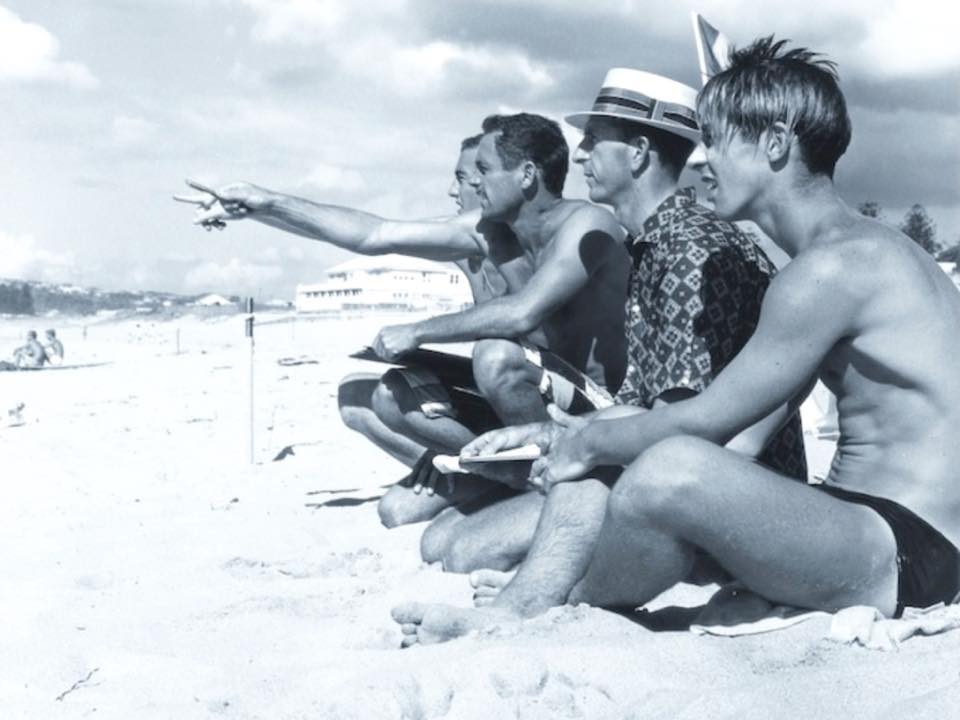
1961 Scott Dillon (pointing with pen), Bob Evans (wearing hat) judging the contest of the South Pacific Board Riders Club at Nth. Narrabeen. Bob Fell far left and Robbie Lane in the speedos on the right. Photo by Ron Perrott - Sydney Living Museum
And then:
Surfboard team to race in Hawaii
By Kerry Yates
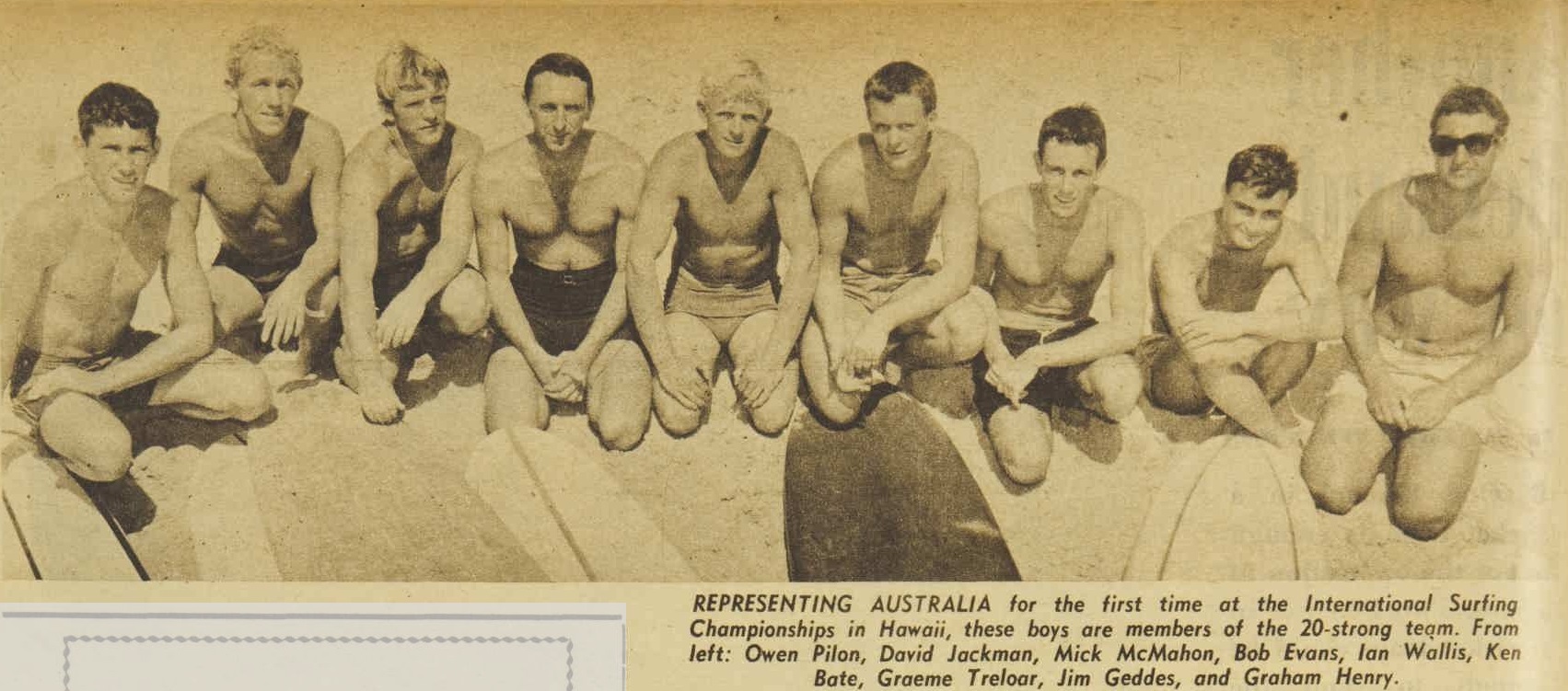
REPRESENTING AUSTRALIA for the first time at the International Surfing Championships in Hawaii, these boys are members of the 20-strong team. From left: Owen Pilon, David Jackman, Mick McMahon, Bob Evans, Ian Wallis, Ken Bate, Graeme Treloar, Jim Geddes, and Graham Henry.
This week 20 Australian surfboard riders, eight of them teenagers, will meet in Hawaii to form a team to compete in the International Surfing Championships at Makaha Beach in December and January.
IT will be the first time Australia has been represented by an organised team at the championships, which bring competitors and spectators from all over the world every year.
All members of the team paid their own fares to realise this dream of most surfboard experts. Some used the savings of two or three years to travel by ship. Others took advantage of an air-line company's "fly now, pay later" plan.
Unlike most overseas travellers, the boys didn't take much luggage. Swimsuits, "ziptweeds" (long pants worn on surfboards), and a few casual clothes were all they thought they'd need - so that's all they took.
And, of course, their boards! Each of them took two boards a special malibu-type, the light and easy-to-handle board used on most Australian beaches, and a big, solid "elephant-gun" board, used in heavy surf.
Bob Evans, of Narrabeen (one of Sydney's northern beaches), organised the team and arranged for it to compete in the championships. The boys will contest junior and senior surfboard champion-ships and body-surfing events.
The South Pacific Surf Riders' Club supplied the team with T-shirts in the Australian national colors-gold and green. This newly formed club, which has a modern clubhouse at Narrabeen, hopes to sponsor an Australian team to Hawaii for the surfing titles each year.
The members of the Australian team are:
Bob Evans, at 32, is the oldest member of the team. He believes that some of the Sydney surf-riders will be a real challenge to the established champions from California.
David Jackman, 21, of Harbord, is a surfboard builder by trade and well known to Sydney board-riders as "Jacko," the boy who rode four big waves over the Queenscliff bombora earlier this year.
John Williams, 21, of Queenscliff, is another surfboard builder.
Owen Pilon, 18, of North Narrabeen, is a process worker in a city electrical firm and has saved for this trip since he started work several years ago.
Graham Henry, 20, of Harbord, is known as "Buz." He works hard at various jobs during the winter so that he can spend the whole of summer riding the waves.
Mike Hickey, 24, of Bilgola, gave up his job as an insurance clerk to become a member of the Australian team.
Jim Geddes, 17, of Narrabeen, sat for the last exam for his Leaving Certificate at his school, Waverley College, a few days before leaving Sydney for Hawaii. Surfboard team to race in Hawaii (1961, December 6). The Australian Women's Weekly (1933 - 1982), p. 4 (Teenagers' Weekly). Retrieved from http://nla.gov.au/nla.news-article51392771
Although not named above, Bernard Farrelly was part of the crew that went. Those boys caught some big waves, despite a flat spell, and they rode them well. Mr. Farrelly (kneeling in center) and some of those mentioned in the above:
THE AUSTRALIAN WOMEN'S WEEKLY Presents Teenagers WEEKLY
August 22, 1962 - Supplement to The Australian Women s Weekly - Not to be sold separately
AUSTRALIAN WINS INTERNATIONAL SURFBOARD CHAMPIONSHIP IN PERU -story page 3 Teenagers' (1962, August 22). The Australian Women's Weekly (1933 - 1982), , p. 1 (Teenagers Weekly). Retrieved from http://nla.gov.au/nla.news-article41860039
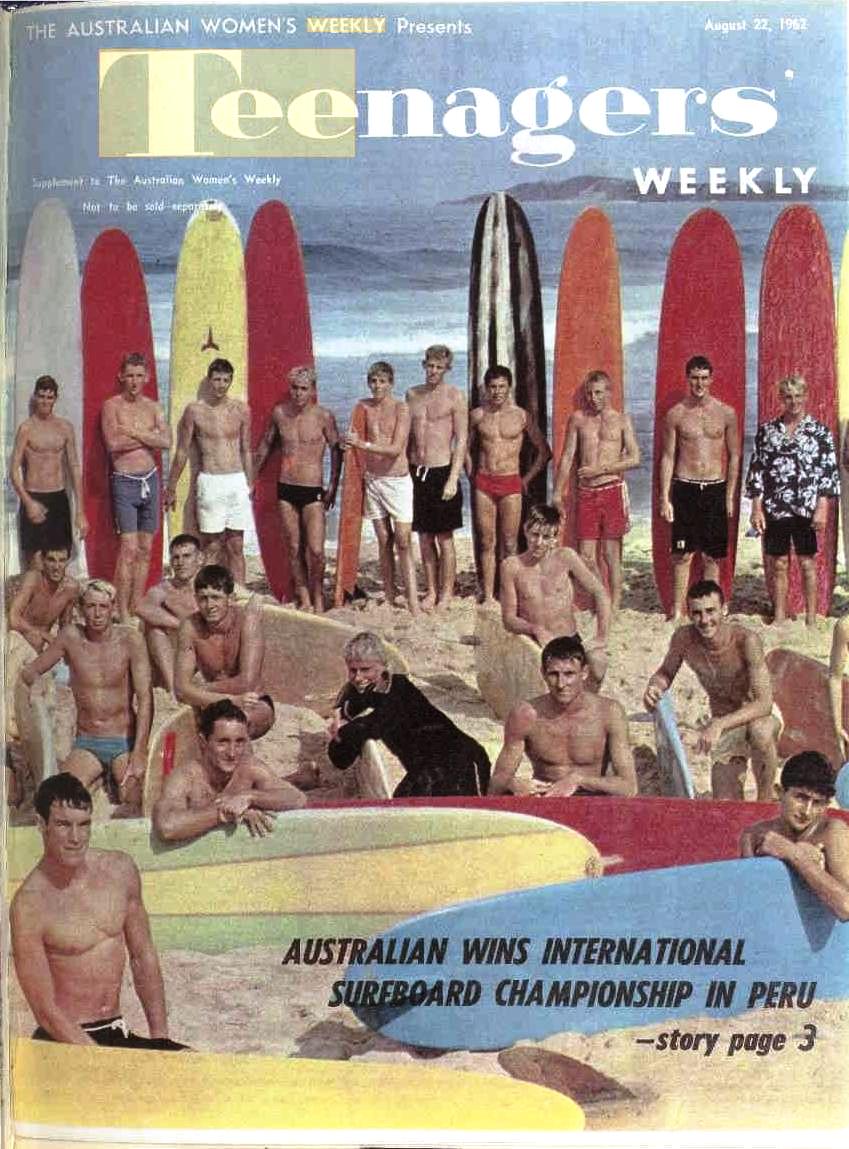
Our cover boys are some of the surfboard riders who competed at Narrabeen, one of Sydney's northern beaches, during the rally organised by the South Pacific Surf Riders Club last season. No title (1962, August 22). The Australian Women's Weekly (1933 - 1982), , p. 3 (Teenagers Weekly). Retrieved from http://nla.gov.au/nla.news-article41860059
From that 'Australian Wins International Championship in Peru' story on page 3.
International surf champ By Kerry Yates
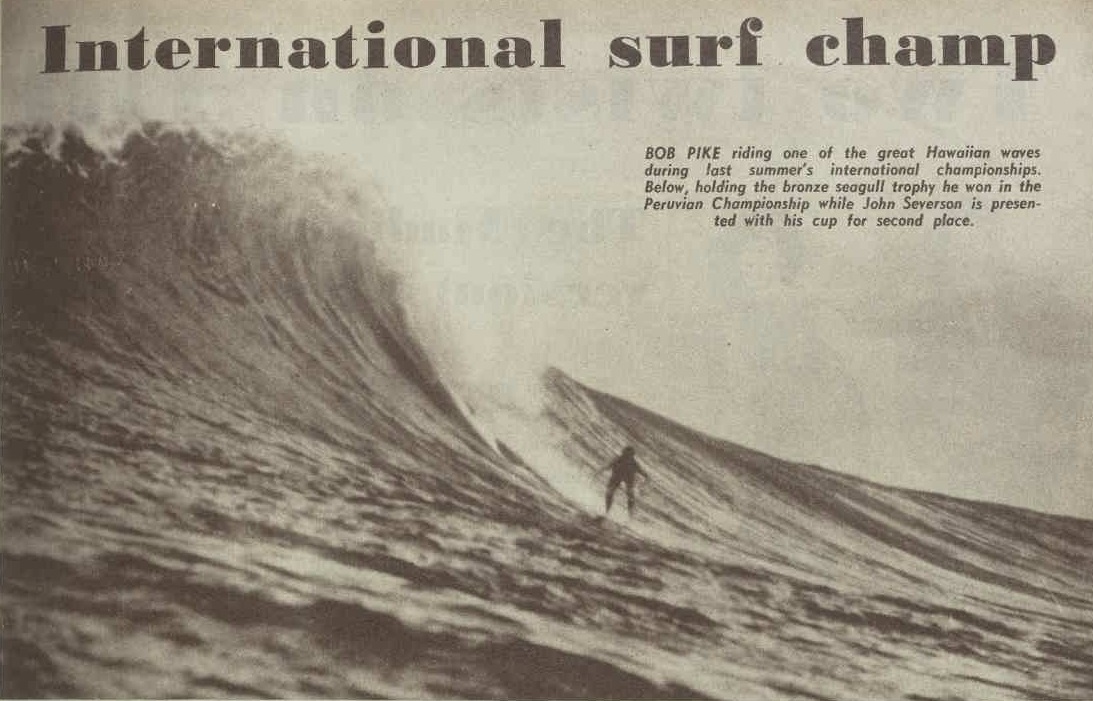
Photo: BOB PIKE riding one of the great Hawaiian waves during last summer's international championships. Photo: Below, holding the bronze seagull trophy he won in the Peruvian Championship while John Severson is presented with his cup for second place.
Wherever the surf is running best - anywhere on the coast between Surfers' Paradise, Queensland, and Torquay, Victoria - there you'll find Bob Pike. Enjoying the sun, sand, and salty spray, he's also training hard, for in a few months he plans to be off again to South America to defend his title of Surfboard Riding Champion of Peru.
BOB, now 22, won the championship last March in competition with the best from Hawaii, California, France, and Peru, and he made such a hit with the people of Lima that they asked him to come back next March - all expenses paid. An old boy of The King's School, Sydney, Bob's home is at Manly, just north of Sydney Heads.
The first Australian to win a surf championship overseas, he was a member of the 20 strong Australian team which competed in the International Surfing Championships at Makaha Beach, Hawaii, last summer. Because he injured a leg he had to drop out before the finals. Several members of the team qualified, but had to return home before the finals, delayed by lack of a suitable surf, were held.
Bob, however, got a lucky break soon after the Hawaiian championships were over. John Severson, a champion Californian rider who was visiting Hawaii for the surfing titles, offered Bob a trip to Peru.
The editor of the American magazine "The Surfer," John won all the board-riding events in last year's Peruvian championships and, before he left, the organisers asked him to arrange for Australian, Hawaiian, and Californian riders to compete in their 1962 championships. John chose Bob and a Sydney friend, Mike Hickey, of Bilgola (another northern Sydney beach), to represent Australia....
It was all a great surprise to Bob, "I didn't even know they surfed in Peru, but what a way to find out!" he said....
For winning the international exhibition board-riding event, Bob was awarded a bronze carving of two seagulls mounted on a marble base. The trophy weighs 36lb. and is valued at £150. Bob said that all the visiting surfers received "royal" treatment.
Servants employed by the Waikiki Surf Club took charge of their surfboards, rubbed them down with paraffin wax, carried them to the water's edge, and even waited to carry them back after Bob and the other boys had finishing riding....
After leaving school at 15, Bob did a two-year course at Sydney Technical College to become a qualified woolclasser. He worked in shearing sheds in N.S.W. and Queensland to save the £600 for the trip to Hawaii. During that time he visited every surf beach in the eastern States.
"Fairy Bower, about a mile off Manly Beach, is THE spot in Australia when the waves are on," he says. "The surf in Hawaii, however, is even better-just like I'd always imagined. But it is very different from ours.
"Waikiki Beach is similar to many Australian beaches-and not so good. But for the keen surfboard rider other Hawaiian beaches have the perfect waves. These beaches - Makaha, Sunset, Alamoana, and the Banzai Pipe-line - have the best surf in the world.
"'The waves, building up to heights of 15 to 25ft. and then dumping on the shore, are very exciting to ride. And the greatest thrill of all is the Banzai Pipeline. This is an area where the waves, often reaching 25ft., curl over at the top to form a 'pipe' before dumping on a rocky shelf of jagged coral.
"And this was the place that put me out of the Hawaiian championships. I lost my board going down the Pipeline, but got out of it with a few scratches and an injured leg. My board, however, was wrecked. All the front was bashed in and the fin was snapped off."International surf champ (1962, August 22). The Australian Women's Weekly (1933 - 1982), , p. 3 (Teenagers Weekly). Retrieved from http://nla.gov.au/nla.news-article41860055
In September 1962 Bob Evans launched the magazine Surfing World with partner Jack Keegan. With the new boards Mr. Dillon's passion for endorphins shifted more towards adrenaline and he too caught a few Bomboras during the swells of 1962:
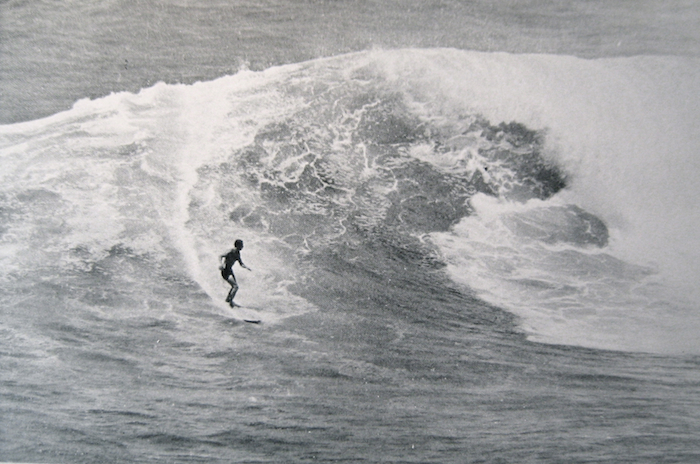
Scott Dillon Bare Island Bombora 1962 (entrance to Botany Bay) - photo Jack Eden, sourced in Margan and Finney’s A Pictorial History of Surfing 1970, p 269
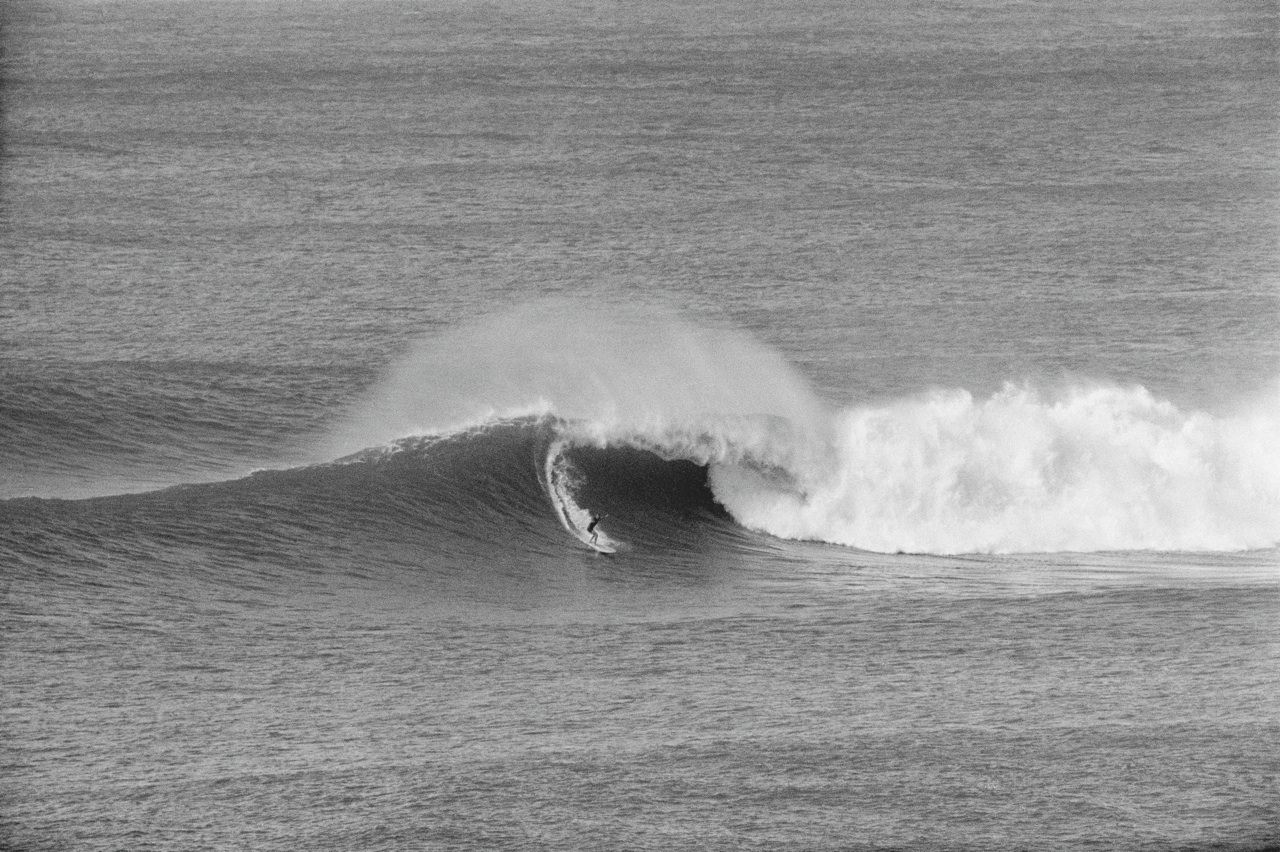
Mr. Dillon on the Queenscliff Bombora, 1962 (some say this is 1963) - another photo by Ron Perrot
At the end of 1962 Australian surfers headed back to Hawaii for the Makaha again. In January 1963:
SURFBOARD WIN TO AUSTRALIAN
HONOLULU, Wednesday (A.A.P.-Reuter)
Australian surfer, Bernard Farrelly of Sydney' won the world surfboard riding title to-day. He captured the championship from nine of the most experienced surfers in the world at the end of an exciting international tournament at the famed Makaha Beach in Hawaii.
Experts who watched the final said Farrelly won because the conditions suited him better than the other finalists, who were all from Hawaii or California. The finalists had to wait two days until tournament officials decided the waves were good enough to make surfing possible.
Farrelly showed remarkable control in his series of rides, building up his points tally, based on the length of ride and form displayed in catching a wave. SURFBOARD WIN TO AUSTRALIAN (1963, January 3). The Canberra Times (ACT : 1926 - 1995), p. 20. Retrieved from http://nla.gov.au/nla.news-article104254829
At the end of 1963 a team went back again - only there was a bit of a kerfuffle this time over a couple of matters:
DEPORTATION ORDER
Stowaways
CHRISTMAS GOODWILL: SURFERS SENT HOME
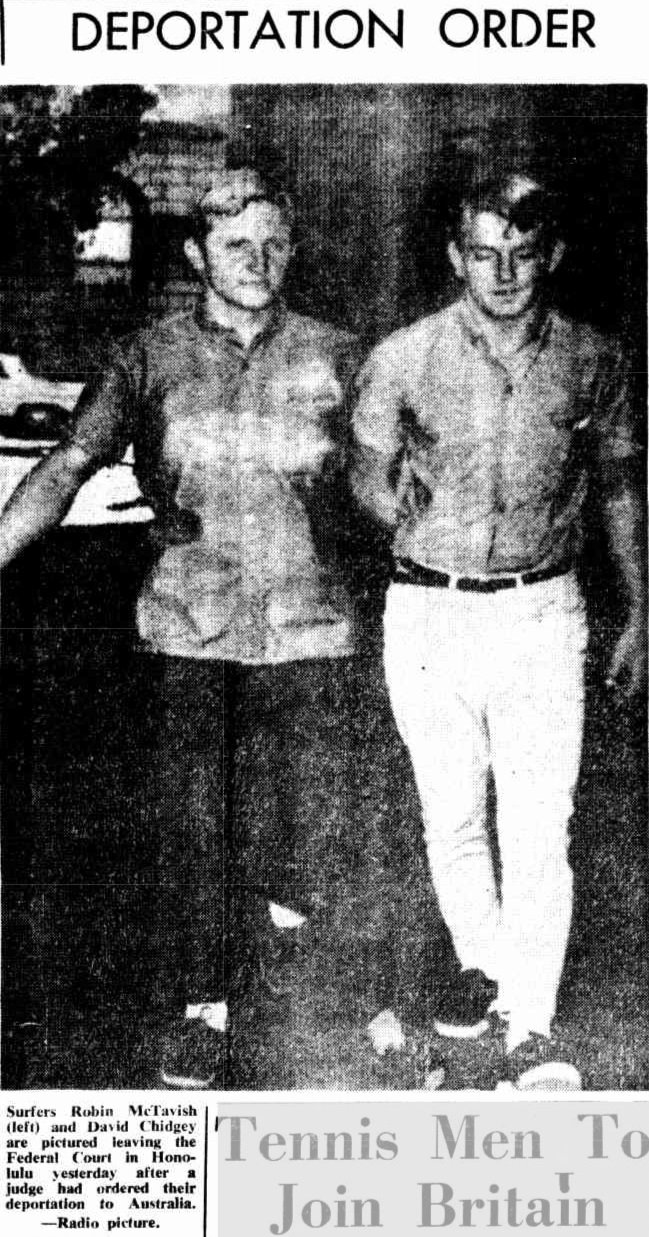
Surfers Robin McTavish (left) and David Chidgey are pictured leaving the Federal Court in Honolulu yesterday after a judge had ordered their deportation to Australia. -Radio picture.
HONOLULU, Friday (A.A,P.). -Two nervous young Sydney surfers, Robert McTavish, 19, and David Chidgey, 17, were ordered to be deported from Hawaii today as illegal visitors who stowed away on the liner Orsova from Sydney.
They are expected to arrive in Australia tomorrow.
The judge in a "spirit of Christmas goodwill" agreed Federal charges would be dropped as long as the boys went back to Australia.
They appeared in court to-day, nervous and with several days' fuzzy growth on their laces but otherwise were clean but casually dressed.
They told reporters they arrived last month and had been camping out at Sunset Beach. They hoped to compete in the international surfing championships here.
They had lived mostly on "beer, peanuts and chocolates" during the eleven-day voyage to Honolulu, the Associated Press of America reported.
They said their trip to Honolulu was "really quite simple."
All it took was a visitor's pass.
They upset security measures of both the U.S. Government and the P. and O. Orient lines when they got their free trip undetected last month.
They boarded the Orsova in Australia on November 5, carrying satchels with bermuda and surfing shorts.
They said they walked up the gangplank, waved good-bye and were off-minus a one-way ticket, but with a total of £48 in their pockets.
A spokesman for P. and O. said the boys' fares were being paid so the company would not be fined for bringing the two youths into the country illegally, A.P. reported.
Loophole
Elaborating on the "visitors pass" procedure, McTavish said that they asked the ship's purser for a visitor's pass, tore off the "boarding" section. and flashed the "disembarking" portion to guards as they got off.
Mr. O'Shea had declined earlier to say how they managed to get on and off the liner because it might be tried by others.
The loophole in security was being plugged to prevent it from recurring.
McTavish said they waited six hours after the other passengers left to make sure they would not be stopped by security guards.
Immigration officials discovered their presence in Hawaii from an Australian newspaper clipping and sought them out at Sunset Beach. DEPORTATION ORDER (1963, December 21). The Canberra Times (ACT : 1926 - 1995), p. 40. Retrieved from http://nla.gov.au/nla.news-article104283106
Disqualified
AUSTRALIAN SURFERS' ENTRIES REJECTED
HONOLULU, Sunday (A.A.P.). -Eight Australian surfers have been disqualified from the international surfing championship at Makaha Beach.
The surfers allegedly submitted their entries after the December 14 deadline. They are Scott Dillon, Bob Pike, Keith Southion, Mick Dooley, Ian Wallace, Barry Andreas, Terry Adams and Jack Mayes.
All had travelled from Sydney and showed up today to compete in the championships. The Australians were upset at the judge's decision.
"Our group travelled 6,000 miles and spent about 20.000 dollars to come to Hawaii," Dillon said.
"Now they tell us we can't take part because of a minor technicality."
The chairman of the meeting, Wally Froiseth, said if an exception was made for Australians, the same would have to be done for others.
Waves
All three Australians who competed in preliminaries yesterday in the senior men's division. Kevin Platt, Rex Blanks and Barry Kelly, were eliminated. Defending champion Bernard (Midget) Farrelly, Queensland champion Dave Hines and Tasmanian champion Barry McGuigan, are Automatically seeded in the semi-finals.
Waves of between 20 and 30 ft., whipped up by midocean winds, are expected for more preliminaries tomorrow.
Stowaways
In Sydney, Australia's two Stowaway surfboard riders, Robin McTavish, 19, and David Chidgey, 17, ran from reporters and photographers at Kingsford Smith Airport Yesterday when they returned from Hawaii.
The youths pushed their way through a large crowd outside the Customs Hall and ran to separate cars. McTavish was met by a friend who whisked him away in a station wagon to avoid cameramen.
Chidgey was met by his parents and a private investigator, Mr. S. Robson, and he also escaped being photographed and interviewed by running to his parents' car.
Criticised
The youths made news this week when they were arrested in Honolulu and were charged with having illegally entered the United States. They stowed away in the liner Orsova, arrived in Hawaii on December I and avoided detection until this week. The F.B.I, yesterday decided that charges against the youths would be dropped if they returned to Australia.
The deputy chairman of P. and O.-Orient in Australia, Mr. J. D. Bates, criticised the youths' action yesterday.
"They have caused this company and the United States authorities much trouble and expense," Mr. Bales said. "A fine of 20,000 dollars was imposed on the Orsova, and the company was forced to repatriate them by air at a cost of over £400," he said.
The company is seeking legal advice on the possibility of taking legal action against the youths. 8 Disqualilfied AUSTRALIAN SURFERS' ENTRIES REJECTED (1963, December 23). The Canberra Times (ACT : 1926 - 1995), p. 28. Retrieved from http://nla.gov.au/nla.news-article104283198
Surfing had taken off, everyone wanted to get into the water - the makers at Brookvale could not make them fast enough:
BOARDS FOR TEENAGERS
A new system enabling teenagers to purchase surfboards from as little as 5/ a week, has been introduced by a retail store organisation.
The store, Nock & Kirby's, with a branch in Fairfield, is offering all types of surfboards in its easy purchase scheme for teenagers. A complete range of boards, including famous names such as Scott Dillon, Wallace, and N & K's own Bombora, are available. Since the offer was introduced; there has been a large Influx of teenage business, according to a store spokesman. BOARDS FOR TEENAGERS (1964, November 25). The Biz (Fairfield, NSW : 1928 - 1972), p. 2. Retrieved from http://nla.gov.au/nla.news-article189523809
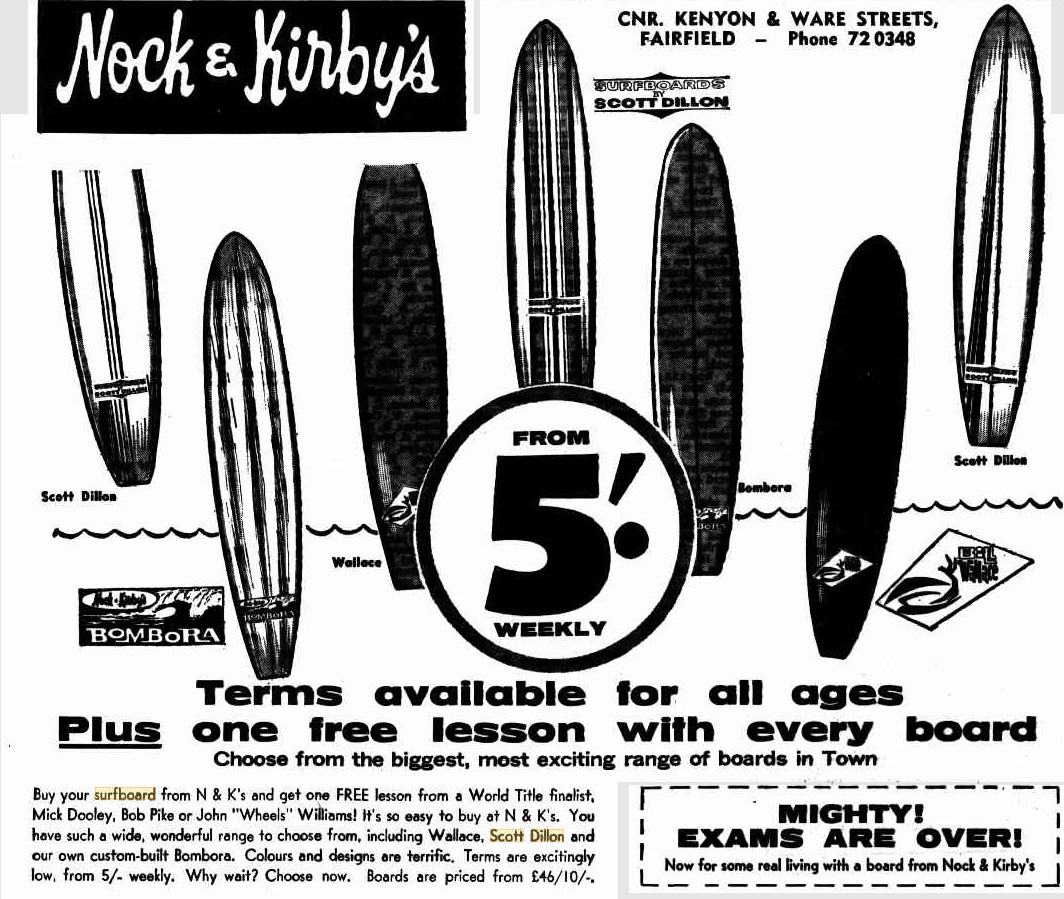
Advertising (1964, September 23). The Canberra Times (ACT : 1926 - 1995), p. 18. Retrieved from http://nla.gov.au/nla.news-article131750463
In the above you can probably read that Mick Dooley, another lad who used to surf on the south side and came north, is in for giving a few lessons. Mick's boards remain the favourite way to go surfing for many - including all those who go in the annual Palmy Longboarders 'Show Us Your Dooleys' comp.
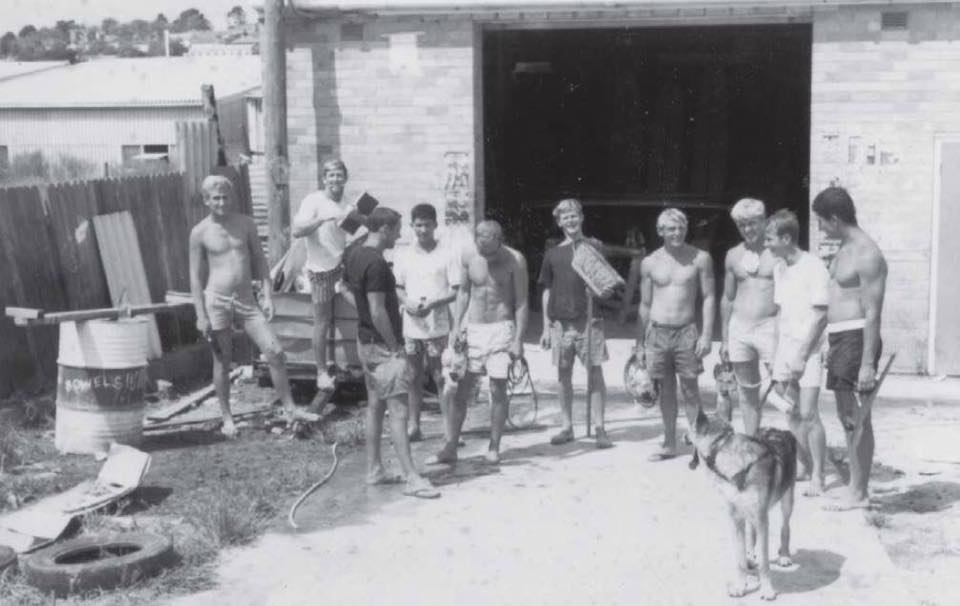
Left to right: Peter Wright, John Wheels Williams, Scott Dillon (in black t-shirt), Chris Beacham, Jim Pike, Swavo, Mick Dooley, Warrick Smith, Gordon Merchant, Ron Adler, Zane the guard dog at Scott Dillon's factory Winbourne road Brookvale Thanks to Diana Dooley for information.
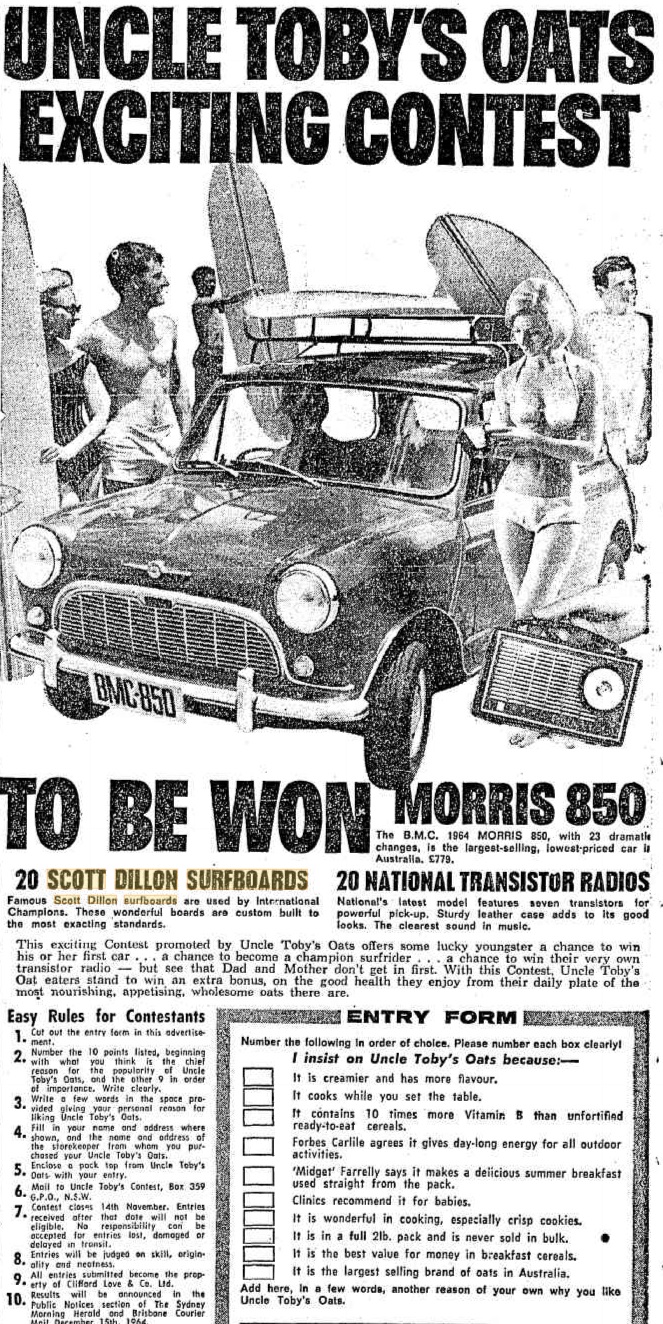
Advertising (1964, November 25). The Biz (Fairfield, NSW : 1928 - 1972), p. 11. Retrieved from http://nla.gov.au/nla.news-article189523813
Victoria Barracks, NSW. 20 July 1966. Nearly $500 worth of surfboard equipment was donated Australian Army troops serving in South Vietnam by seven manufacturers. Pictured receiving the equipment from Denis McDonagh of McDonagh Bros Surf Boards Pty, Ltd, Harbord Road, Brookvale, is the Acting Chief of Staff, Colonel P. Tancred (second from left).
The manufacturers with their gifts are, left to right: Messrs Lance Platt (L. and J. Platt, Surfrider Boards Shorts, Foam Street, Harbord); Danny Keogh (Keyo Surf Boards Pty Ltd, Sydenham Road, Brookvale); Scott Dillon (Scott Dillon Surf Boards Pty Ltd, Winbourne Road, Brookvale); Bob Brewster (Manly Surf Shop and Stor-A-Bord, Pittwater Road, Manly); Gordon Woods (Gordon Woods Surf Boards Pty Ltd, Harbord Road, Brookvale); Bill Wallace (Wallace Surf Boards, Winbourne Road, Brookvale); Barry Bennett (Barry Bennett Surf Boards Pty Ltd, Harbord Road, Brookvale). Photo courtesy the Australian War Memorial.
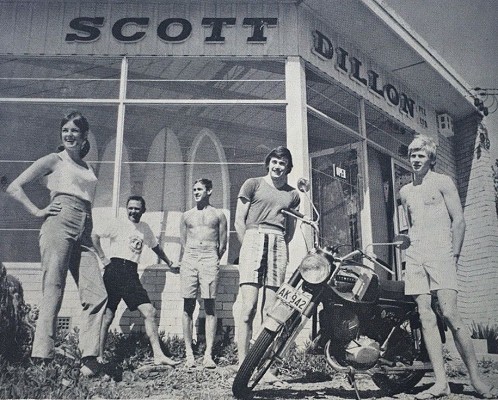
Scott Dillon and crew advertising Baron Surfwear, 1968. Surfing World, September 1968, Volume 11 Number 3 page.
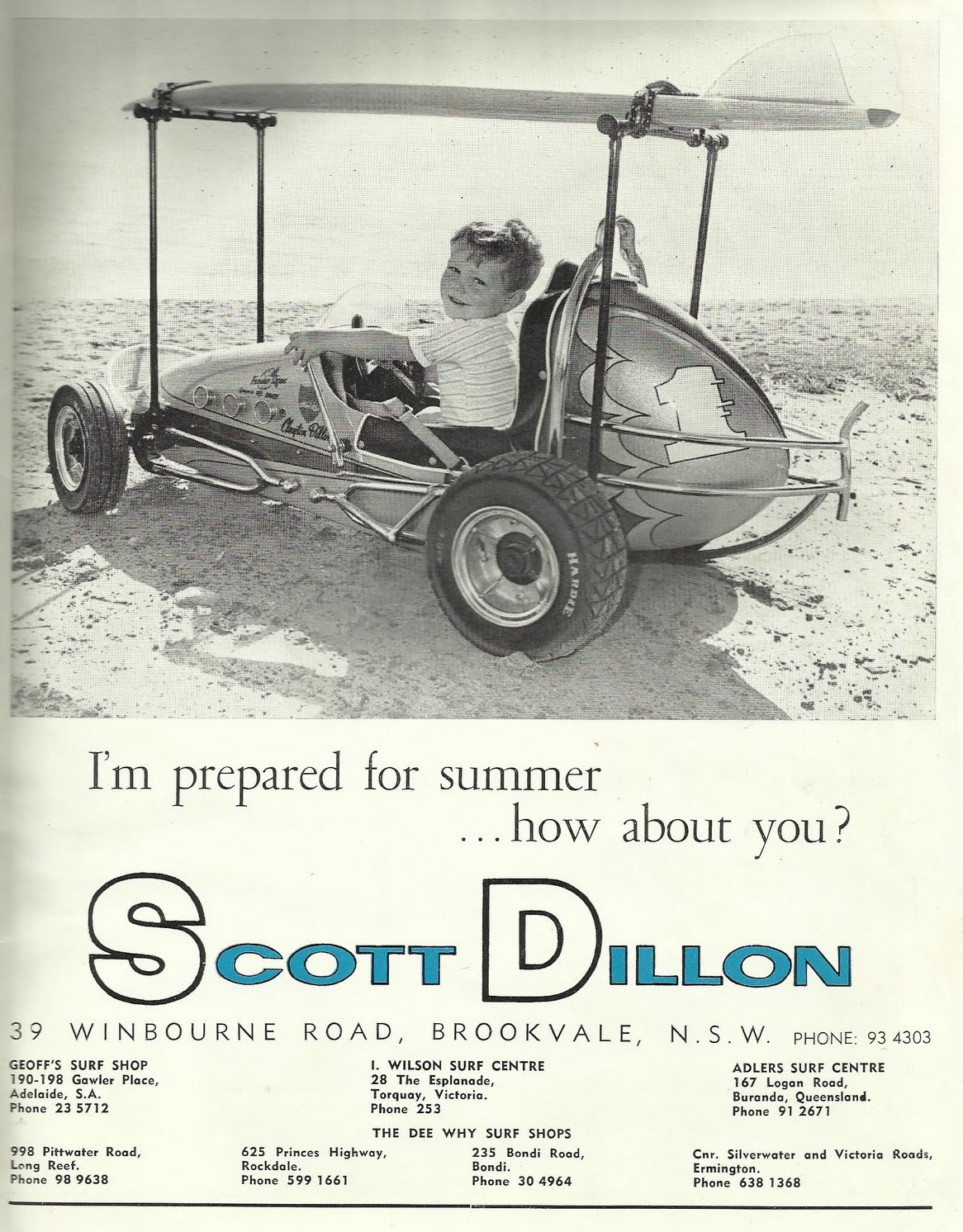
Some of his words from a 2011 interview by Steve Magro, no slouch behind the wheel himself and an Australian Speedway historian with Scotty, give a few insights into why Clay (Clayton) his son features in that rather snazzy vehicle above:
"My son Clayton drove around the Sydney Showground in a purpose built baby Midget I built him. At 40mph. He was aged three, he drove three laps and the Child welfare officers were at my door the next day! I was the starter for events at the Showground.
"I still hold the two lap record for Midgets on the old dirt track at Liverpool. I made most of the fibreglass bodies for the Midgets, Super Modifieds and Solos. The whole of the British Solo Team would party at my home in Forestville. Mel Kenyon often called in, helped me in setting up my cars. Both my Sedans, an EH Holden and my Rambler, were of fibreglass. I beat Gene Welch in one of his first Sedan races at Liverpool. I was a personal friend of Steve Raymond and Mike Raymond, and with Mike took a Speedway Tour of the USA in the 1970s.
"Johnny Langfield would spend Sundays together with our families either boating, diving...as well as with the British Solo Team. We partied at Mike Raymond's home, often after the races when the likes of Mel Kenyon, Gene Welch, Gary Patterson etc were in town.
"Scott Dillon #40, my car number, and also my age when I started racing."
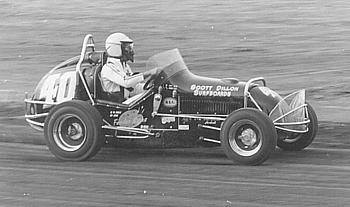
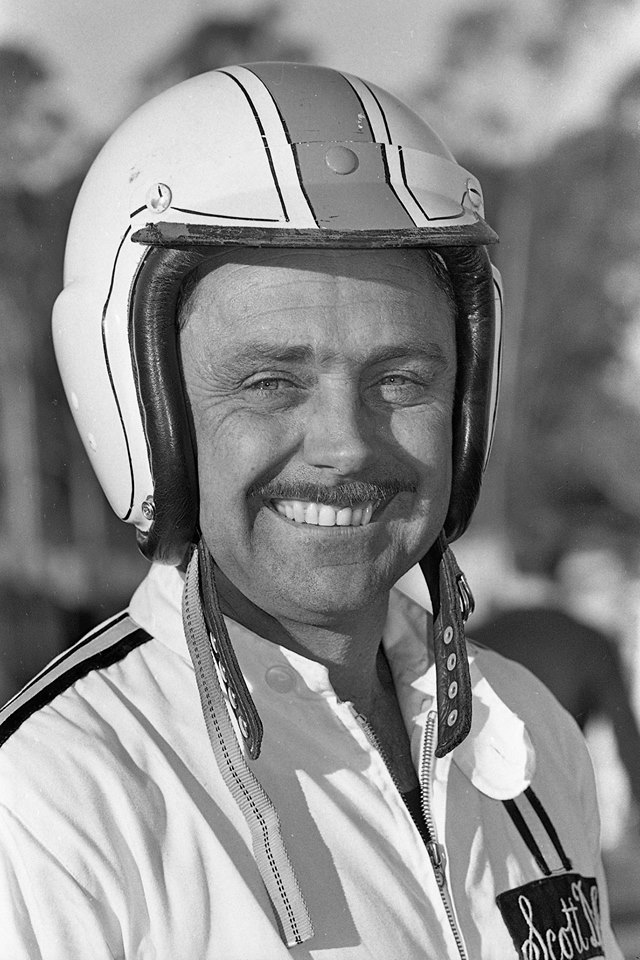
Scott Dillon at Liverpool Speedway in 1968
He moved into racing sedans and other 'messing about with car episodes:

Scott Dillon tests the strength of a surfboard with a Holden special - a Jack Eden photo kindly donated to The Collection Australian National Maritime Museum by Jack and Dawn Eden
In the late 1970s he moved north to Coffs Harbour, still making boards. In 1999 he opened the Legends Surf Museum which the opening of a new section of highway closed down in 2014 - as so many new roads do. You can see some of Dick Hooles photos on the Coffs website HERE
He was still pretty active up until then - could share a yarn and a beer still.
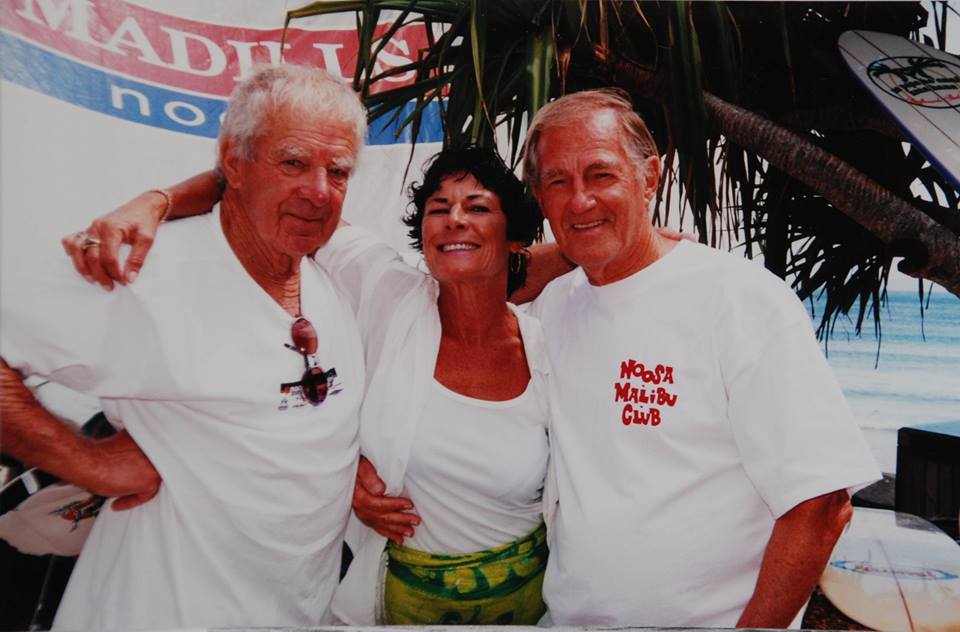
Gordon Woods, Pearl Turton and Jack Eden. Noosa Surf Festival 2002. Photo courtesy Ron Turton - Pearl's first Board was a Dillon, she still has the receipt
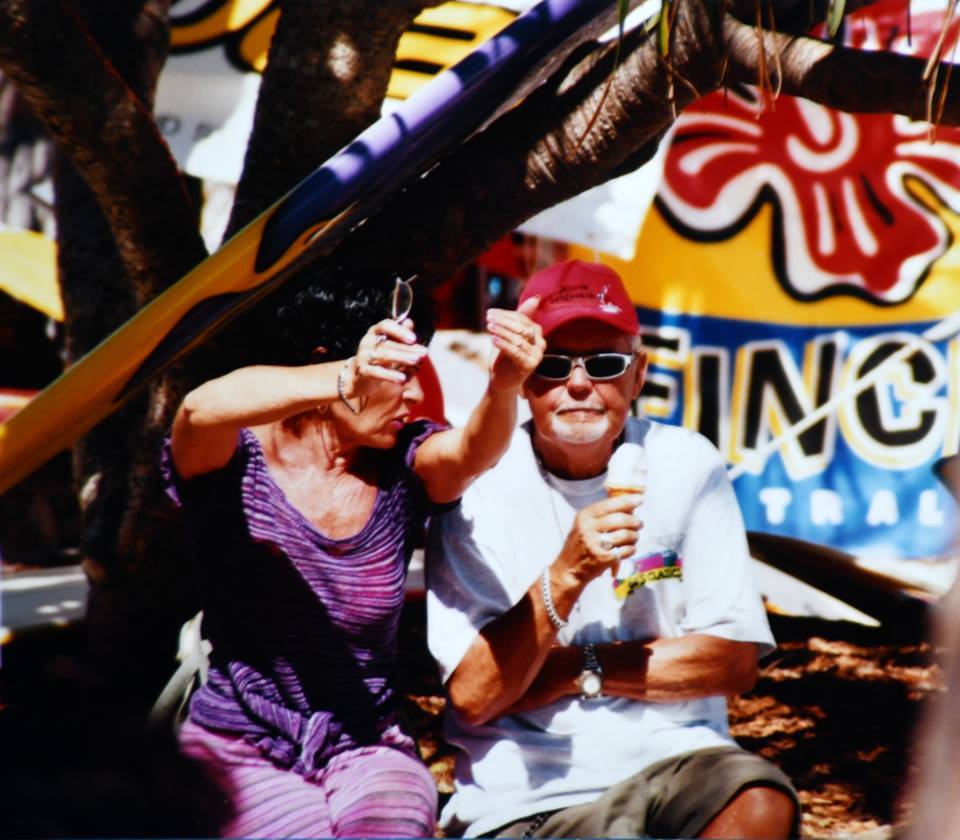
Pearl and Scott, Noosa 2000 Photo by Mick Marlin
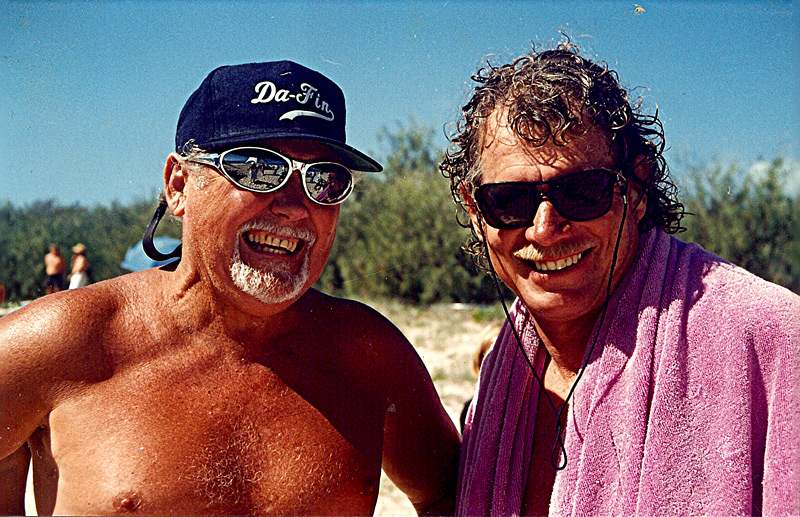
Scotty with Bernard Midget Farrelly at the 64 world titles re-enactment in Noosa. Photo courtesy Ron Turton
In 2013 the pretty poor scribe putting this overview together phoned Scotty while the museum was still open and had a chat. The plan was to have a longer chat once all that Christmas-New Years stuff was got through. We had a lot in common - Tasmania, parents who were jazzy, although mine were among that mob on those boards in the 1950's and turning up to the first ever events like Bells in the '60's. Then the blasted deconstructors came through early in 2014 and you couldn't get hold of him - should have persisted!
The chat we did have was lovely. He was a delightful man, kind, gentle, not full of himself - a dad and a grand-dad. He expected me to 'pop in' if we got that way over that Christmas - which was the plan, but then you know how things go when you plan something.
This Summer it's time to drag out those boards again and catch a wave. If you can't catch a wave anymore, at least go stand in the ocean. Maybe have a beer.
This Summer, grab hold of your loved ones, you family and friends, and give them that hug - don't hold back, there's not a moment to lose and nothing will be lost by loving each other every single moment that's sent to us.
Thanks for all you did for us Scotty, you and the gentleman Mr. Phil Jarratt dubbed 'The Brookvale Six' in his and filmmaker Shaun Cairns Men of Wood and Foam; Barry Bennett, Scott Dillon, Denny Keogh, Greg McDonagh, Bill Wallace and Gordon Woods opened a world many of us live in - and it is there we will continue to celebrate you and charge forward into tomorrow.

|
VALE Scott Brewster Dillon.pdf Size : 998.81 Kb Type : pdf |
VALE Scott Brewster Dillon
August 19, 1928 – December 11, 2018
passed peacefully at 9.15 p.m.
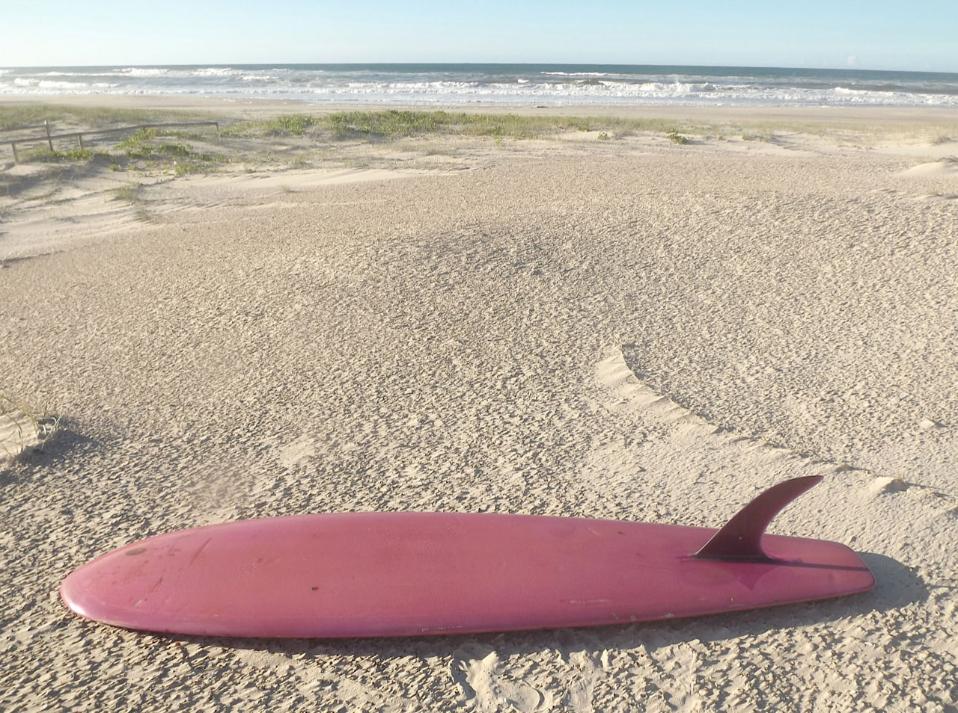
Scott Dillon Stringerless Tracker Surfboard - circa 1968
